#recently watched macross for the first time
Explore tagged Tumblr posts
Text
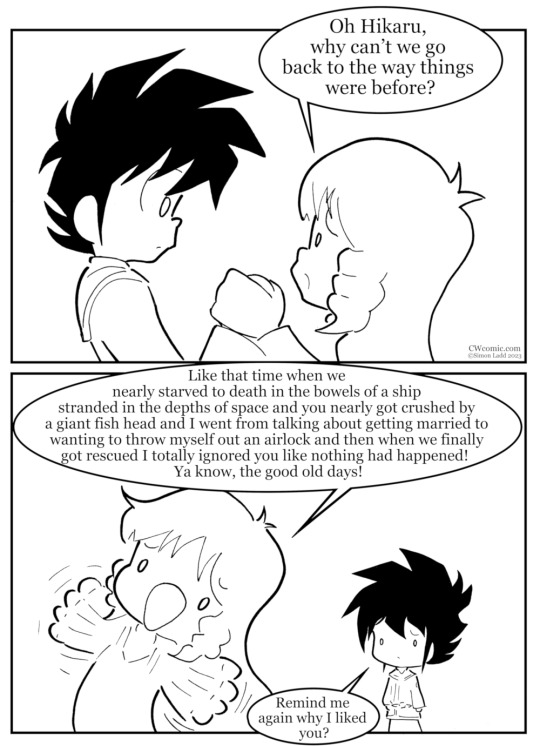
Weekly Anime Comic: Macross - page 39
So, I've pretty much always been in the "Minmay sucks" camp, but this most recent watch-through of Macross has really given me a new appreciation of just how much of that is the fault of the show's overall writing as opposed to the character herself. Like, Minmay trying to get Hikaru to quit the military here comes across as really clueless and childish, just in case you didn't already get that from the comic. But at the same time, I don't think it'd rub me the wrong way half as bad as it does if the other characters were allowed to just respond to her like real people. But instead of saying the obvious answer ("Look, even if we stop fighting them, that won't make them stop fighting US."), we get this weird esoteric crap about why Minmay sings and whatever. Aside from coming across as really pretentious and not what any normal person would say in that situation, I think dialog like this actually hinders the development of Minmay's character. It kind of leaves her stranded in the stupid stuff she said, since now the only way the show provides for her to grow out of it is via some meaningless psychobabble rather than a more obvious "Oh, I guess that was the wrong thing to say" realization. I dunno if there's a cultural aspect at work here, like maybe the writers were afraid of having the show come across as even more militaristic than it already does so they drove the dialog in a different direction, I just know that Minmay ultimately got really shafted by the show.
BUT ANYWAY, with this page I officially get into the final episode of Macross... BUT WE'LL BE HERE FOR A WHILE. I've actually got not just one but TWO more comics to follow, though in fairness one of them is an idea I've had cooking pretty much since we started. Still, it's technically about episode 36, which will make that the single most comic'd episode of any show in standard Weekly Anime Comic history! I have to say "standard" because there's also the extra comics I'm doing on the Gunbuster OVAs. Those are totally throwing off the average. BUT SPEAKING OF WHICH, don't forget that I've got even more comics going up on Patreon as we speak! Not only would you be able to read those Gunbuster comics right now if you were a parton, but you could ALSO see the remaining Macross comics AND the first few Dirty Pair comics AND vote on which classic Digimon series I'll start doing comics on this year! That last one's running out of time, too, so if you want in on that decision, don't wait around to do it! Conventional Wisdom / Patreon
3 notes
·
View notes
Text
The Importance of Big Cool Sci-Fi Stuff
(This was originally posted on Blogspot on March 13, 2023)

I finished watching Turn A Gundam recently, and it’s already cemented itself as one of my favorite Gundam shows and anime in general. But one detail I appreciate is that, even with its Americana setting, it still works in some interesting, immense technological set pieces that give a great sense of scale to the show in the portions where it heads to outer space. To put it bluntly, I appreciate it when science fiction has what I like to call “Big Cool Sci-Fi Stuff,” both for the novelty but also realizing the unique potential the medium has to create a unique sense of wonder.

A key plot point in the middle of Turn A is an orbital base called the Sackträger, which functions as a giant rotating space catapult flying around the Earth that docks and launches ships with enough momentum to overcome the Earth’s gravity and maintain inertia to reach the Moon. It doesn’t feature for many episodes, and in hindsight it mostly exists to set up the need for the journey to the Moon to take some time and thus more episodes.
But as a setpiece on its own, it’s really fun. There’s drama as the ship tries to position itself so the speeding catapult can catch it, which it only manages as Loran and Harry use their mecha to boost the ship’s thrust. The rest of the episode deals with the tension created by two enemy ships being docked so close that neither can risk attacking without destroying the station and thus their chance to get to the moon first. There are even moments where Loran and Sochie explore the size of the station with their mecha, with them and enemy mecha holding on to belted handles to traverse the immense structure. These details make the Sackträger a more unique and even characterized location with its different rules that affect the way the characters act, which also makes the episode more memorable on its own despite the location not getting revisited afterwards.
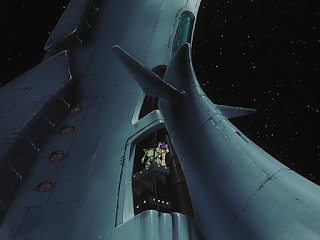
The show has similar setpieces in the later episodes, from a drifting agricultural colony to giant lunar data pods, and this got me thinking about what these design choices all accomplish; it’s all Big Cool Sci-Fi stuff. Sci-Fi is easy to do as a generic coat of paint where there’s some futuristic vehicles, spaceships, or robots. But one potential that I love, most so with media dealing with space, is the freedom to play around with massive structures and scales, technological or otherwise, that are much harder to do in other genres. Fantasy comes close at points, but visual science fiction has the added benefit of getting to use advanced technology to add to the size of these things that makes them more distinct. Space stations and larger ships, advanced towers and fortresses, natural megastructures, ruins, or even astronomical phenomena like nebulae can all fit under the umbrella of Big Cool Sci Fi Stuff, though from my view it best fits more with technological structures.

A similar anime example that stands out to me is the Sveto city from Heavy Metal L-Gaim. Without getting into too many spoilers, the enemy capital of Sveto is a giant floating city that shifts around the surface of the oceanic planet Gustgal, but it also has huge sprawling foundations and corridors that give off a great sense of scale. Again, there wouldn’t be that much difference to the broad strokes of story if this was just a tech city on a continent, but these facets of its design give a great sense of the city’s technological and size scale.
Big Cool Sci Fi Stuff is fairly common across science fiction and especially mecha anime, from the Zentradi fortress in Macross, and even the Macross itself, the Babylon project in Patlabor, the space elevator in Orguss, the Buff Clan’s Gando Rowa from Ideon, and the Iserholm Forteess from Legend of the Galactic Heroes to name a few. It’s not just any regular space station or structure, but one whose size is made a point within the story and used to stage different situations. The technological-enabled size of all of these structures makes them interesting locations on their own and also gives way to many different aesthetics used to render their scale compared to everything else.

My personal favorite example from growing up was seeing the myriad illustrations from the Terran Trade Authority books at my grandparents’ house. I mostly didn’t bother reading the actual stories or descriptions a lot of the time because I was so enthralled by the detailed and colorful illustrations on their own, and many of them conveyed that sense of wonder to me by how immense these varying spacecraft and stations were.
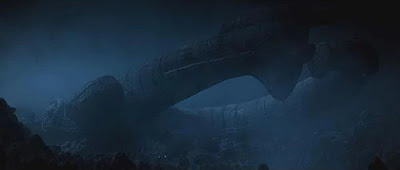
Aside from just wonder, Big Cool Sci Fi Stuff can also evoke larger feelings of mystery and dread as well. From the immense size and near endless internal rows of the Borg Cubes in Star Trek, the hulking derelict ship at the start of Alien, the unknown giant lenses from Story of your Life/Arrival, or the immense innards of the Citadel in Half Life 2, these all use the smallness of the humans present to instill the size of the forces within that could possibly wipe out mankind. Even the Death Star in Star Wars works on that same logic in-story as a symbol of fear by being a massive, moon-sized station that dwarfs every possible challenger and can annihilate civilizations.
More than anything else, just seeing small humans or even large spacecraft and mecha dwarfed by these towering megastructures is an engaging experience because it’s something far beyond the normal scope of humanity. Even without going into the precise scientific details of how they work, and perhaps not all of them are entirely plausible, the sense of scale alone gives a great sense of wonder that’s really only possible in science fiction. Not every science fiction work needs Big Cool Sci Fi Stuff to achieve wonder on its own, but it’s always something I appreciate whenever it's worked in.
26 notes
·
View notes
Photo
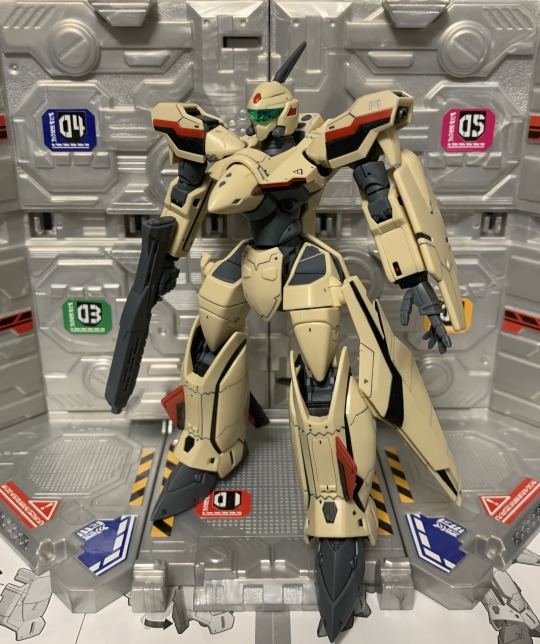
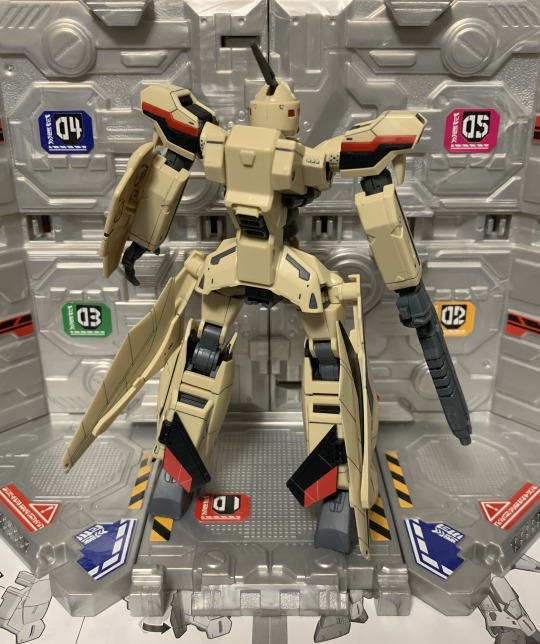



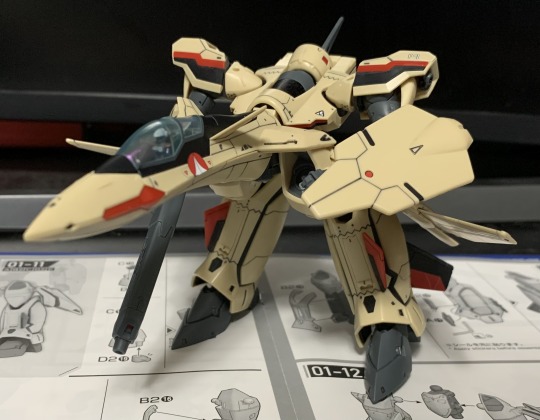
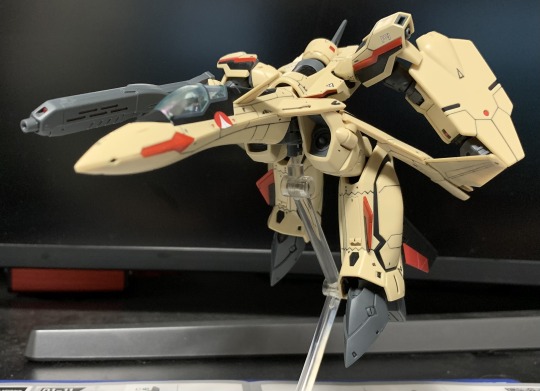
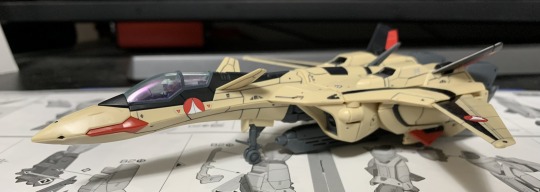
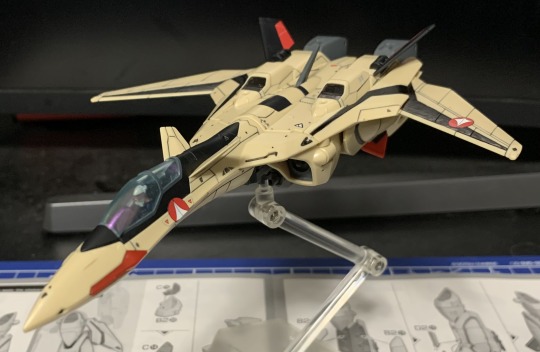
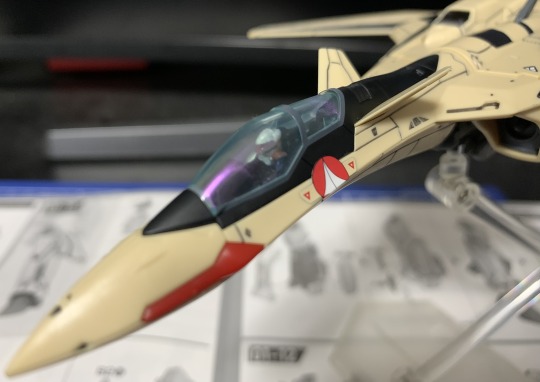
YF-19
I have watched a little Macross, including this movie! I don’t remember anything from Marcross Plus, but I know I’ve seen it! Honestly, I was just very curious how the Ban/Nam designers would do a Valkyrie, since transforming figures of these are very high end, and I think the final result works, though could be a little simplified in some areas.
The Good: For starters, this kit is very posable. The Battroid has a very good set of ranges, while the Girwalk has access to a lot of the same if you’re able to maneuver around the extended wings. The fighter doesn’t pose, but that’s to be expected.
The transformation is ok, focusing mostly on swapping out large core pieces, and doing a little bit of transforming, mostly of the legs, in order to achieve the desired form.

The Bad: The wing units are a little finicky. Apart from that, the transformation, while mostly solid, has a few oddities to it, like the swapping out of the back unit, or how the front skirt is always moved around and pegged into weird places.
The Details: I swapped between painting and using stickers quite a bit on this one. There’s plenty of standard panel lining, and I tried to use black paint most of the time, but there were a few instances where it was too much of a hassle? I also used metallic red on a few places, and did a simple paint scheme of the pilot suit.
Overall, it’s an interesting experience, though not my favorite. They recently revealed a second type of Valkyrie, and I don’t have any interest in doing any more of this style of Macross kits after the first one. I would say, if you like Macross, this is a great, cheap, and fairly fun experience, but if you’re just looking for a fun model kit your money would be better spent elsewhere.
36 notes
·
View notes
Text
Hiya, so one of my pals over on @drawn-with-passion have me as a volunteer to do a get-to-know-me post in which they were got tagged at by @van-zieksy (hope you don't mind).
Here's a get-to-know-me post:
1. Favorite Color:
Royal purple 💜
2. Currently reading 📚
@baroksfacescar's newest fanfic, "Beauty in Every Kind"
3. Last song I listened to 🎶
Disco Dad by Landon Burch
I recently got hooked on the Future Funk genre after listening to some Daft Punk tribute mix last year. It was up on my recommendation on YouTube and I just happened to stumbled upon it! I eventually got hooked! If you love a fusion of EDM with a hint of Japanese oldies funk, this is the genre for you!
⭐ Fave Future Funk artists are: Night Tempo, Macross 82-99, Mikazuki BIG WAVE, Desired, Vantage, AnTgry, and Sui Uzi
4. Last series I've watched 📺
The newest episode of the Obi-Wan Kenobi series!
Yes, I love love LOOOOOVE Star Wars!!! ❤️
I didn't like the series at first growing up cuz I thought it was such a nerdy franchise even my brother's and cousins try to get me into it...until I got hooked on an episode of Star Wars The Clone Wars in 2012, and the rest is history.
5. Last movie I've watched 🎞️🍿
White Snake 🤍 🐍
I'm not a movie watcher as much anymore...but I just have to give this a go! I also love the Wuxia genre and donghua (MDZS, SVSSS, Thousand Autumns, and Legend of Exorcism)
Yes, I'm aware about the Netflix sequel, Green Snake, but I still haven't seen that yet! But hopefully will later.
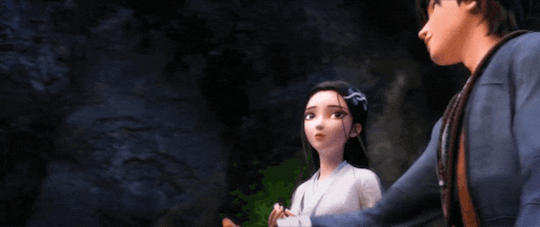
6. 😋 Cravings at the Moment 😋
Nothing at the moment...I already had my fill of burgers and fries awhile ago.
7. Currently Working On 🎨
- As some of might know (or not), I'm also a fan of Transformers. I am currently working on a Miko Nakadai fanzine. I'm just starting off by designing logos and banners for the zine's social media pages.
The zine has a Tumblr for now: @tfp-miko-zine
- Aside from that, a rather large fanart of Clone Force 99 from Star Wars: The Bad Batch. Will post the piece soon as well as some prints for my shop and some process pics. It's my first time drawing the crew together and a huge group illustration OMG LOL
- And a personal painting that is kinda overdue that I'm supposed to create for my former boss.
I'm gonna taaaaag:
@baroksfacescar 🍷
Okie-dokie! That is all for now!!!
Don't be afraid to ask me some Q's too and I'll do the best of my ability to respond!
5 notes
·
View notes
Note
I haven't seen many recent series either. I feel like we're in a bit of a cartoon slump. Houseki no kuni is a little old and I haven't seen it, but the art is pretty I think. And I hear really good things about King's Ranking. From first glance of KR I don't feel like I'd be interested but I think I shouldn't judge a book by its cover. However for ongoing shows I HAVE watched, I think I can only suggest Mob Psycho and Beastars.
I've mostly been watching old cartoons myself lately, but it can be really refreshing to revisit or watch older shows for the first time! If you haven't seen Tweeny Witches (Mahou Shoujo-Tai Arusu) I really suggest it if you liked something like Little Witch Academia. Or you could delve into 90's mecha animes; there's a lot of adorable comedy centered ones!
Thank you, I'll check out KR and someone already recommended Houseki no Kuni. I've seen clips of Mob Psycho around twitter and Beastars looks... interesting.
Looked up Tweeny Witches and I remember getting a poster of it with my OtakuUSA magazine lol. Might watch it along with LWA since I never really finished it.
And don't get me started on 90's mecha anime, I've been meaning to watch at least one Macross series.
Thanks again!!
3 notes
·
View notes
Text
On Miyuki Inaba and Macross:
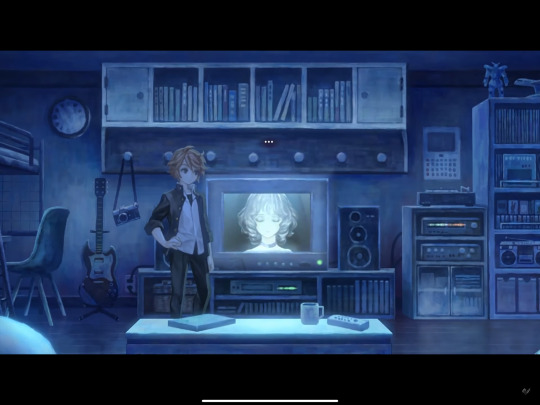
I’ve heard nothing but love for wave 2-10 of destruction; but I’ve realized that the scene loses some of its magic for western audience because they don’t know it’s a shout out.
So today I want to break down for you today the biggest reference in 13 Sentinels you most likely missed out on; Miyuki Inaba, Lynn Minmay and The Super Dimensional Fortess Macross.
Join me under the cut for massive spoilers for Sentinels of course, and a nearly 40 year old anime you’ve never seen.
I think everyone knows Sentinels is chock full of sci-fi shout outs. From War of the Worlds, to Terminator, The Matrix, heck even GroundHog’s day, the list goes on and on. Most western audiences will be able to spot the bulk, so why haven’t you heard of Macross?
Simply put, copyright battles. In 1985, Hamorny Gold stitched together three unrelated animes to create Robotech. One of the anime series involved was Macross and Harmony Gold has kept a tight leash on the copyright preventing the series from ever getting a real proper English release ever since.
...so what is Macross?
Well, in super blunt Wikipedia stolen summaries:
Macross (マクロス, Makurosu, English: /məˈkrɒs/) is a Japanese science fiction mecha anime media franchise/media mix, created by Studio Nue (most prominently mechanical designer Shōji Kawamori) and Artland in 1982. The franchise features a fictional history of Earth and the human race after the year 1999, as well as the history of humanoid civilization in the Milky Way. It consists of four TV series, four movies, six OVAs, one light novel, and five manga series, all sponsored by Big West Advertising, in addition to 40 video games set in the Macross universe, 2 crossover games, and a wide variety of physical merchandise.
If you asked me to boil the series down to it’s three staples I’d pick the following three elements. Big robot fights, love triangles and music, usually all interplaying together to make some of the most exciting fight scenes in anime.
The series is going strong in Japan ever since its 1982 release, with the most recent series Macross Delta’s newest film “Absolute Live!!!!!!” getting its first teaser trailer days before I sat down to write this post. It’s insanely big in Japan and you’ve probably seen a half dozen Macross references if you’ve watched a sci-fi anime before. Most likely the signature missile blast.
Sentinels pulls specifically from the 1984 film: the Super Dimensional Fortress Macross: Do You Remember Love? The story is largely a shortened version of the first tv series which aired in 82 and is considered in canon a film retelling of the events.
The film focuses on a colony ship adrift through space suddenly being attacked by an alien race called the Zentardi, it’s both a war film and a very quiet drama all tangled up in the three central characters of Hikaru Ichijo, the young pilot, Misa Hayase, one of the bridge officers and then Miss Macross herself; Lynn Minmay. An idol singer aborad the ship who has during its journey become a huge celebrity after starting as a simple waitress at her family’s restaurant.
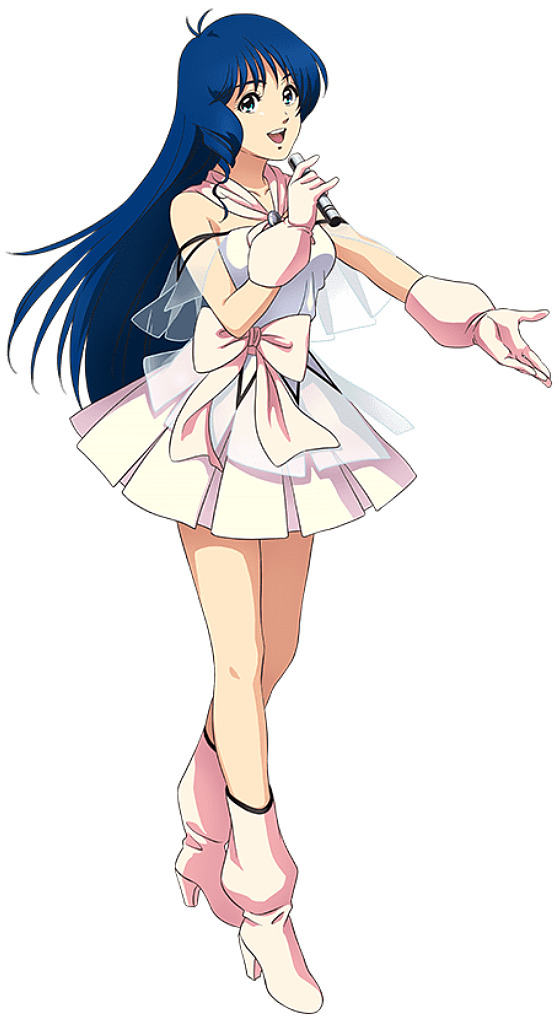
Minmay is considered something of the face of the series and while other characters may never come up again in its extended universe, the story of Lynn Minmay is akin to legend in later entries in the seires.
When mankind was faced with these invaders, there was one simple thing that managed to send the enemy into disarray, the music of Lynn Minmay shocked the Zentardi who had no concept of culture and music. They end up capturing her and the other two leads during the course of the film and while the others manage to escape; Minmay is trapped behind with the Zentardi.
They eventually ask her to look and exam a relic they’ve kept on board their ship, and Minmay discovers it’s of all things, a song.

So, if isn’t obvious enough by this description alone, Miyuki is modeled after Minmay. It’s not a 1 to 1, but the curls in her hair and the style of her outfit make it even more obvious.
They have a lot of the same general vibes too, Minmay over the course of the film becomes a tragic melancholic figure and a symbol of the war effort against her will. Her sweet dreamy smile and glittering energy become subdued as she faces set back over setback. She remains strong up until a point behind her facade of confidence until she discovers Hikaru now has feelings for Misa. Culminating in the finale of the film where a despair filled Minmay refuses to sing because it all seems pointless.
Miyuki foils this of course with her journey from the plucky Tomi Kisaragi of a prior loop to a ghost in the machine; a somber beautiful figure but a changed person. She only has this role she’s taken on in the end. All she can do to impact the out come of this fight is sing and hope Shu hears her.
In the finale, Minmay is given a wake up call and asked by Hikaru to sing her song and try to save the lives of everyone left aboard the macross. Roused from her despair, Minmay agrees and the final battle is set to the tunes of the song the Zentardi had shown her, now with lyrics Misa had translated. At long last reaching them and halting the conflict.
This is of course, what 2-10 is a direct reference too. Miyuki sings Seaside Vacation until she can’t be heard any longer.
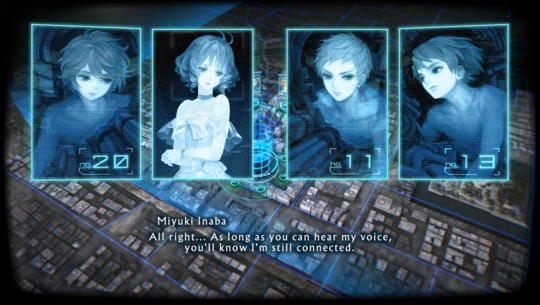
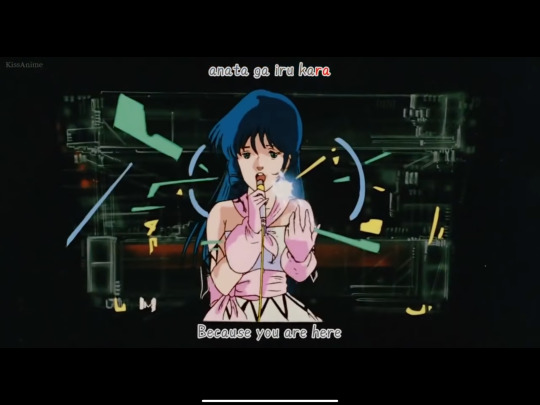
Even if you’ve never seen the film, the clip alone is a treat in itself. It’s a lovely piece of animation
But Macross’s influences go deeper than just Miyuki and the original Macross. In Macross Plus, the primary idol is the artificial intelligence Sharon Apple. She is also it’s major villian as her AI becomes destabilized during the course of the film.
With the illegal modifications installed in Sharon takes control of the capital of Earth with her music and nearly destroys the city. Miyuki’s character is all Minmay, but her role in the story is a heroic Sharon Apple.
And outside of Miyuki, Macross references and influences can be spotted in Tomi’s story in which she and Nenji are trapped in 2025 and he begins to fall for her mirrors the arc that occurs between Hikaru and Misa after they escape the clutches of the Zentardi. The pair find themselves trapped on a mysterious planet, which turns out to be Earth rampaged by the Zentardi. Misa and Hikaru’s hostility towards each other fades as they try to come to grips with this truth. They spend a long time alone in the ruins and eventually fall in love before eventually being saved by the Macross. Which, is roughly what occurs in Tomi’s story between her and Nenji.
Shu’s story as well, with the minor focus on his confusion of his feelings towards Tomi and Yuki are also arguably a tongue in cheek reference towards the series many Love triangles, which aren’t always true triangles but always remain a corner stone of the series.
Does Shu actually have feelings towards Tomi? No but she’s showing up everywhere and it’s left him a little out of sorts and plays into the misinformation sentinels feeds you, leading you to think there’s a triangle of some sorts:
Maybe they’re stretches, but considering it was stated in an interview the film was a huge inspiration for the game, I wouldn’t be shocked. I found the interview on twitter back in November but can’t track it down now and I’m v. sad
There’s also the matter of the Protoculture.
The Macross is a massive colony ship, sent out into space with the goal of returning to earth after a long space voyage to insure humanity’s survival, much like the probes the 2188 colony sent out. Misa and Hikaru return to find this was the only thing that’s had prevented humanity from being wiped by the Zentardi.
While on earth, Misa and Hikaru manages to discover a set of ruins of a highly advanced civilization that had created both humanity and the Zentardi. The protoculture.
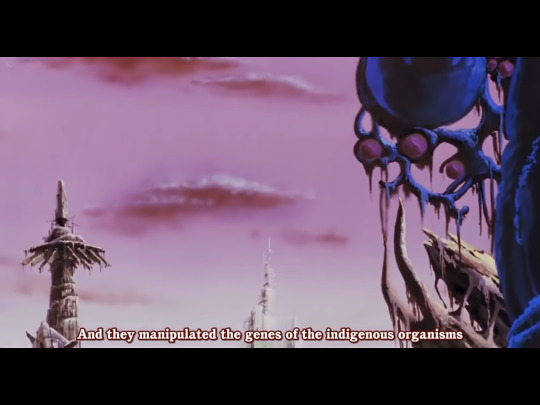
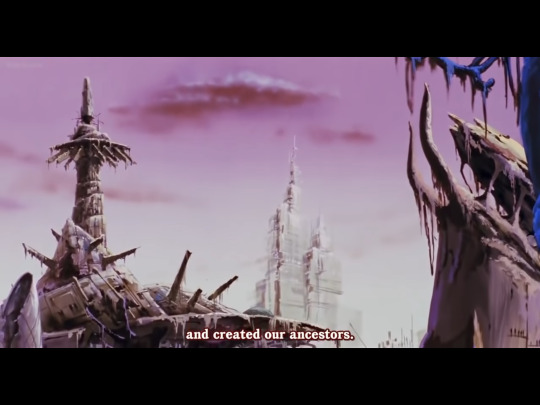
The logs they manage to Find reveal that their inventions grew too great and they have all but disappeared from the universe, but humanity in the end are aliens as well. The invading Zentardi were just tools used by the Protoculture to wage war on itself and contributed to the death of their people.
The song Minmay sings is a relic of the Protoculture, an ancient highly advanced civilization from thousands of years ago.
Now Hm. Why does that sound familiar? What was it Fluffy said about 2188 and the Deimos code....

They’re obviously not 1-1 references, but Sentinels was such a labor of love that pulled from so many genres it’s nice to see such an iconic series get a well thought out reference.
I hope this was something of a fun read and gives you a better love of Miyuki and 2-10.
I don’t know if I’d recommend getting into Macross if you liked Sentinels, but if you’re interested send me an ask and I could probably give you a helpful breakdown. I love both series so much and consider them my top two sci-fi!
#macross#13 sentinels: aegis rim#miyuki inaba#lynn minmay#sugar speaks#i almost always listen to macross tunes while working on 13sar fics and am really passionate about both series and ready to shill lmao#i wanted more pictures and tumblr said....no#sugar’s 13 sar collection
53 notes
·
View notes
Photo

Cosplay Over 40 group founders : Jae and Ana
Today I’m highlighting one of the Instagram share pages / theme pages, I followed, Cosplay Over 40. For the past few years, I’ve reached out to various pages asking about how their page got started.
Ana: We arrived at cosplaying via two different avenues. Jae and I were both into anime, comic-book, and science-fiction geeks growing up. He loved — still loves — Macross and Robotech, I was more Star Blazers, Superfriends, and Star Trek. In high school and college, my friends and I made our own Star Trek uniforms and attended Star Trek events in New York City back when it wasn't called cosplaying. It wasn't even called costuming. It was just being a Star Trek geek. I bought my first official costume — a Star Trek Next Generation science jumpsuit — in grad school, and that just opened the door to what would become cosplaying. I pulled together costumes of Ranma Saotome from Ranma 1/2, Jessie from Pokemon, and Kim Possible, and I'd wear them for Halloween, to library events, and to comic-book expos... what would eventually become the cons we know today.
Jae: I have always loved taking photos. I'd take photos of friends, of people at events I'd attend. I love photography. It's my way of being involved without being the center of attention and without being stuck on the sidelines. I became a sports and portrait photographer, but cosplay always called to me. It just appeals to my geek side. And with Ana getting more and more into cosplay, it only seemed natural for me to turn to cosplay photography.
Ana: At first, we were just thrilled to be part of the cosplay scene. I love fandom meet-ups. I love meeting voice actors and artists, especially those behind the anime and comic-book characters I love. When people come up to me and ask to take photos with my cosplay, it's such a deeply satisfying feeling. My cosplay made people happy, made people smile.
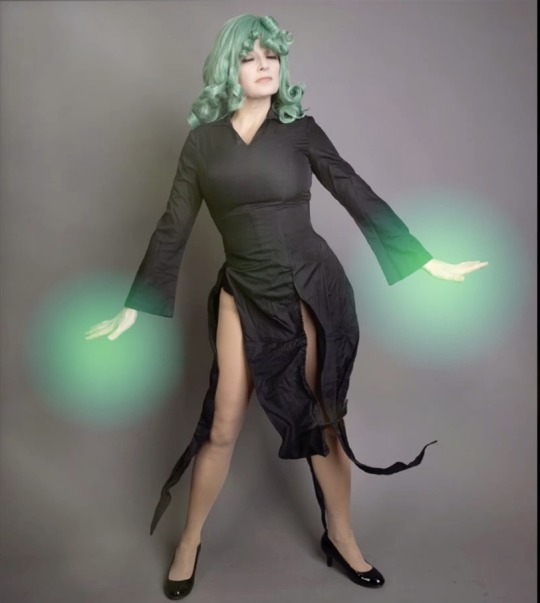
Jae: We got really caught up in that scene, seeing other people reacting to Ana's cosplays and to so many other amazing cosplays.
Ana: And then we started to notice a different reaction. I think I first started noticing it at some meet-ups. There's be the main group, and then there'd be a handful of us on the outside. This happened more and more often, and it took me a few years to realize that those of us on the outside were older than the central groups. Once I realized this, my eyes flew wide open. At cons, I started noticing that the photographers would ignore fabulous, intricate cosplays worn by older cosplayers and would flock to take photos of teenagers and 20-somethings in wigs and bikinis.
Jae: It really pissed us off. Here were so many people who obviously put a lot of blood, sweat, and tears into creating armor and amazing sewing projects, and they were barely being given a glance. I started going out of my way to photograph these cosplayers... and all over them were our age or older.
Ana: It finally came to a head in 2019. We spent a weekend at an out-of-state con, and we — myself and all the other older cosplayers — might as well have been invisible.
Jae: One of the other photographers actually told me he only takes photos of "young, pretty girls."
Ana: I told Jae that we couldn't just let this kind of behavior continue. We had to stand up and do something about it, let the older cosplayers know how wonderful they are. I have a Master's in public communications and I've worked as a social-media specialist for various companies and organizations since the mid 1990s. Since cosplay is such a visual art, I went straight to Instagram and searched for "cosplay" and our age range: 40. There was absolutely nothing there.
Jae: We also checked 50. There was nothing. Then we checked 30. Two accounts came up, both dead in the water. One hadn't posted since 2015, and one hadn't posted since 2018.
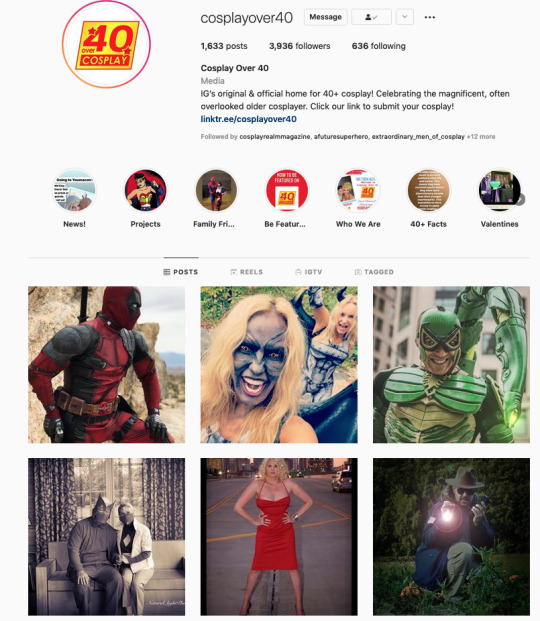
Ana: Just to be safe, we also checked "old," "older," "geezer," all those types of terms. There was absolutely nothing. Given what we'd seen over the years at cosplay events, this really didn't surprise us, but it still hit us hard that there was no representation for the older cosplayer. I spent a couple of weeks outlining the guidelines we would follow. We looked at successful cosplay feature sites like @sharingcosplay and @women.of.cosplay. We knew we wanted to feature individuals, to give each cosplayer their time in the spotlight. We also wanted it to be structured. We didn't want to give one cosplayer a huge write-up, then give the next one just a few sentences. Everyone had to be showcased equally. After all, the whole reason we were doing this was because of the inequality we'd seen.
Jae: I felt we had to go beyond Instagram with this. I'd recently gotten into videography. I felt — still feel — that a multimedia market exists for the older cosplayer. I told Ana that we had to take this to podcasts, to YouTube, to even a magazine specializing in the older cosplayer.
Ana: I've worked as an assistant editor and managing editor for several magazines and I currently work as a contributing writer for two specialty magazines, so creating a magazine was something I totally agreed with. I also agreed with the podcasts and You Tube channel. That kind of thing is right up Jae's alley.
Jae: We decided that we would make this a multimedia venture, focusing on the older cosplayer and letting the world know how fabulous older cosplayers are. Older cosplayers have the discretionary income to dedicate to cosplaying. At this age, they're serious about their hobby and it's a true labor of love. It's not just something they do with their friends a couple of times a year. It's a passion. And the skill I've seen, the dedication... it all needed to be celebrated.
Ana: But we decided to start with social media first. We launched on Instagram on June 28, 2019, with Facebook and Twitter following shortly after. We did encounter a small glitch...
Jae: There was a Facebook group with a very similar name...
Ana: We checked them out and saw they were a community group that shared photos of themselves and events they attended, nothing remotely like what we were doing and have planned for the future. Having studied journalism law and having consulted with a copyright specialist, we knew we were in the clear to bring our dream to life: celebrating the magnificent, often-overlooked older cosplayer.

Jae: The reception has been incredible. Not a week goes by that we don't get a message or email from a cosplayer thrilled to have found a place that showcases people their age. Our age.
Ana: We also get messages from people letting us know they'll be turning 40 soon and can't wait to be featured. We get people who message us on their 40th birthday, eager to be featured. Or who message us just days before their 40th birthday, asking to be featured on their special day. It's been wonderful. It's been mind blowing.
Jae: We've gone to several cons, and the reception there has been amazing. We've spoken to so many older cosplayers, every single one of whom had experienced ageism at these type of events and who were absolutely thrilled to discover that our focus is them and only them.
Ana: And then the pandemic hit.
Jae: It really sucked, from the photography standpoint, to watch everything come to a halt. But this also gave us the push we needed to move forward with our plans.
Ana: We started producing cosplay video projects, open to any cosplayer over the age of 40. We figured that cosplayers were looking for ways to continue cosplaying — safely — during the pandemic, looking for ways to interact with other cosplayers. We'd present a theme and state a deadline for submission.
Jae: We had a tremendous response.
Ana: Jae took all the video clips and edited them into amazing montages that really showcased how amazing cosplayers over 40 truly are. For one video, our Fight Challenge, we had more than 50 cosplayers participate from all over the world.
Jae: We also held an online con in March 2020.
Ana: Yes, our "Con Together." It was nine days of scheduled fandom meet-ups and cosplay sharing. We even had an artist's alley.
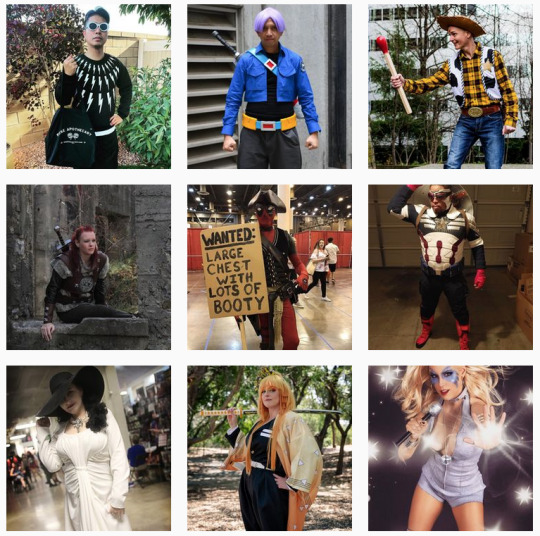
Jae: But right now, we've moved on to the next stages of our Cosplay Over 40 plans.
Ana: Jae has been building a dedicated podcast studio outfitted with all sorts of live-streaming equipment. I'm sure I'm not using the right terminology for this. It's Jae's baby, and I trust him implicitly to have it ready to go later this summer. I've also started working on the inaugural issue of Cosplay Over 40 magazine. The editorial content has been decided, I've reached out to cosplayers and others in the cosplay community for interviews and photos, and I'm really looking forward to laying out the issue and getting it to print.
Jae: But even with these new platforms, we are not slowing down with our original presence on Instagram.
Ana: Absolutely not! We're still growing — we just passed 3,900 followers — and we are now actually part of the @SharingCosplay family of feature pages. We are always looking for new cosplayers to feature and we always invite those we've featured in the past to share more of their cosplays with us. We have cosplayers in their 40s, 50s, 60s, and even in their 70s sending in their photos. Like I said before, it's mind blowing.
Jae: There's a sense of satisfaction that comes from showcasing cosplayers in our age demographic and beyond, of showing the world how awesome cosplayers over 40 truly are.
https://linktr.ee/cosplayover40
youtube
6 notes
·
View notes
Text
Studio Graviton
I have been researching Studio Graviton for a while, a small studio notable for its activities during the ‘80s, and I’ll articulate what I found in this post here. As for why this small studio is relevant, let’s say an individual with the name of Hideaki Anno was one of the founders, and it was there that he had his debut as a director.
So it all starts with Anno back in 1984, just after finishing his work on “Macross: Do You Remember Love?”. To get an idea about the nature of Studio Graviton we need to understand Anno’s situation back then, as he was still a newling in the industry, not even sure if he was going to continue in this line of work or not. It’s well-known that Anno moved to Tokyo based on an invitation from Miyazaki to work on Nausicaa, after dropping from university, but he moved with only his backpack and barely any money. It was a hard time for him, moving from one place to another, sleeping in the studio when he could, and so on. People might think the harsh working conditions of the anime industry are something recent, yet, while admittingly getting a bit worse recently, it’s always been like that, especially for newcomers.
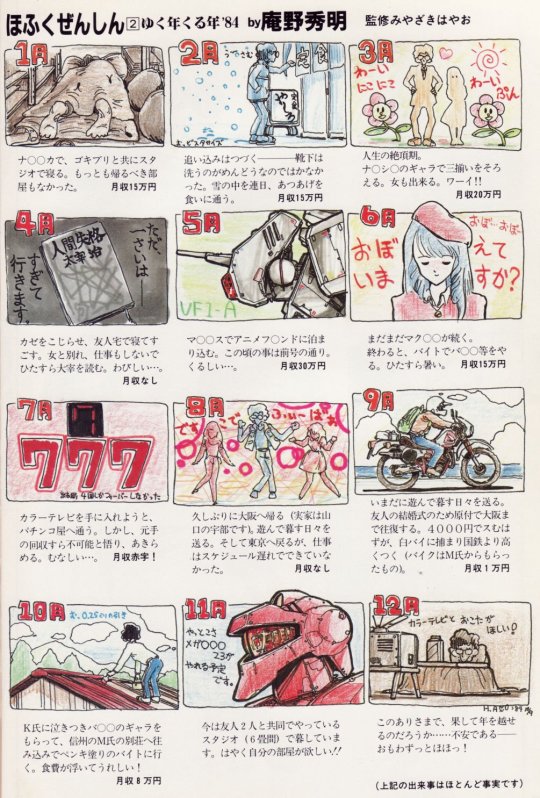
A comic drawn by Anno detailing how he spent 1984. Translation here.
While working on Do You Remember Love he met with one young animator called Shoichi Masuo. They and two other friends, Kouji Itou and Katsuhiko Nishijima, decided to establish their own studio and called it Graviton. Exact date for establishing the studio is around June of that year, and Anno worked on Megazone 23 there.
I say studio because that is used to refer to Graviton, but let’s clarify the nature of this “studio” first. Studios in general are basically a place for creators to gather and work on the projects at hand, a place where they put their work material and tools and the like. The word “studio” might give off an impression of a place akin to a company or an organization of sorts, with representatives and management staff, yet this isn’t the case for most anime studios. The majority small studios exist mostly for the purpose of providing a place for creators to work in, with maybe one or two persons with management roles such as a producer to organize work and secure new contracts, but not always.
Graviton may be a bit special, but most small studios, which is to say most anime studios, are closer to Graviton than they are to larger studios like Bones or Toei. Graviton was just a rented apartment for the studio members to stay in whenever they pleased, with expenses shared among them. They didn’t have to work together on the same project, and they didn’t have any specific responsibilities or obligations, they could come and go whenever they wanted, really. Anno for example kept switching places between Graviton and Gainax a few times during those years. Another more recent example is Takafumi Hori, who works from Trigger on other studios’ projects, and him having his desk at Trigger is due to his good friendship with other studio members.
The benefits of having a shared working place like Graviton are obvious I believe, like sharing expenses or getting to work on other studio members’ projects if there is a vacancy, I’ll mention some examples on that in a moment. My examples are mainly related to Anno, because getting information on him and his career is much easier, but each one of the original studio members had a notable career of his own and is worth checking out.
So starting with the projects Anno worked on while being at Graviton we have the first part of Megazone-23 where he did some scenes. I guess he worked on the infamous Pop Chaser 4 while being at Graviton too, and then went back to Gainax to work on Wings of Honneamise, and then went back and forth between the two studios juggling different projects till around 1988, when he took over as the director of Gunbuster. He didn’t come back to Graviton after that, probably because his financial situation became much more stable and just settled at Gainax.
Among the things Anno worked on back then were ads, one of them was an ad for a music player from JVC, which he did at Gainax in 1987. The ad evidently has nothing to do with neither music nor electrical devices, which is what the company’s representatives said if I’m not mistaken, but it’s a good piece of animation. Another ad, the really interesting one, was a promotional video for a game on NES called “Mugen Senshi Valis”. This ad is by the way the first directorial (paid) work for Anno. He did it in the same year but this time at Graviton, and I’d have said by this point that the studio at which he worked was a mere difference in location no more, yet this ad was a rare collaboration between all of Studio Graviton members. Also, as a side note, Anno spent the money he got from this job on buying a cooler for the studio in place of the one that broke.
youtube
The promotional video was promoted in magazines and posters with focus on two points: The first is being directed by Hideaki Anno, a genius animator who played a major role in DAICON and Wings of Honneamise. The second is having Katsuhiko Nishijima, the director of Project A-Ko, as a character designer and animation director. I think that the target audience for this promotional video was obvious. The production company behind this was Sunrise, and I think they were the ones who reached out to Anno in one way or another to direct this, who in turn invited his friends from Graviton, so as a result Graviton was credited with the animation.
Director - Storyboard: Hideaki Anno
Character Designer - Animation Director: Katsuhiko Nishijima
Key Animation: Graviton
Backgrounds: Atelier Musa
Finishing: Studio Fantasia
Production: Hideoki Tomoika(Sunrise)
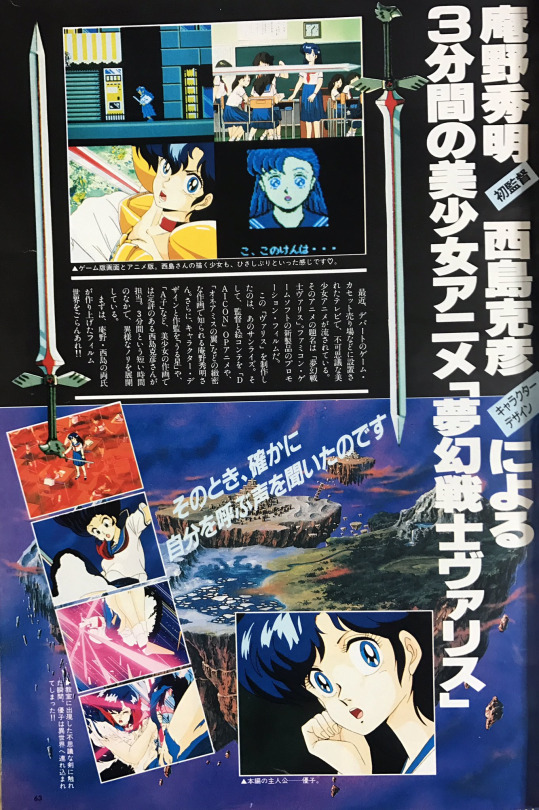
This is a great opportunity to talk about Nishijima, who was a key figure in the ‘80s. He wanted to become a mangaka at first, but wanting to make a living drove him to enter a university, which he left after his first year to join the anime industry. Applying for a place at Sunrise at first, after watching Gundam during his year at the university, he was referred to Studio Live because Sunrise didn’t accept new in-betweeners at the time. He passed the entry test there and had his first gig as an in-betweener on Cyborg 009 episode 27 I believe. His first key animation came shortly thereafter on episode 26 of Maeterlinck no Aoi Tori: Tyltyl Mytyl no Bōken Ryokō.
He started attracting attention due to his scenes in Urusei Yatsura, being a big fan of the manga to begin with he personally asked Toyo Ashida(Studio Live’s president) to work on the TV anime. There he started developing his own style, and although a hint of Kanadism was there, his style was pretty distinct even early on, which led to his scenes standing out from the rest. Even when Studio Live stopped working on Urusei Yatsura, Nishijima moved to Deen where he continued working on it. It can be said that the long time he spent working on Urusei Yatsura culminated in his magnum opus, Project A-Ko, but that’s a whole discussion of its own for another time. Before Nishijima left Studio Live he participated in a dozen of their shows, such as Minky Momo and Dr. Slump Arale-chan, and even after leaving he kept ties with them and worked on things like the Kyoufu no Bio Ningen Saishuu Kyoushi OVA.
There’re a lot of characteristics for his style. First there’s the way he draws bodies, as he was known for drawing girls with sexy bodies while keeping the faces simple and cute with large round eyes. No wonder such style was popular among otaku of the day, especially considering the “idol” status of Lum from Urusei Yatsura back then. His popularity only increased after Project A-Ko OVA, and the Valis PV came shortly after all of that.
Nishijima’s designs are pretty beautiful if you ask me, and this PV is one of the few works where you’ll find his designs. Aside from that his scenes are a joy to watch. I think he was capable of adding a sense of dynamism to his scenes without unnecessary or excessive movement, which not a lot of young animators could do giving his style a hint of “maturity” so to speak, all the while without losing attractiveness. He achieves this through his good use of perspective, for example, or his unique impact frames, which are a favourite of mine.
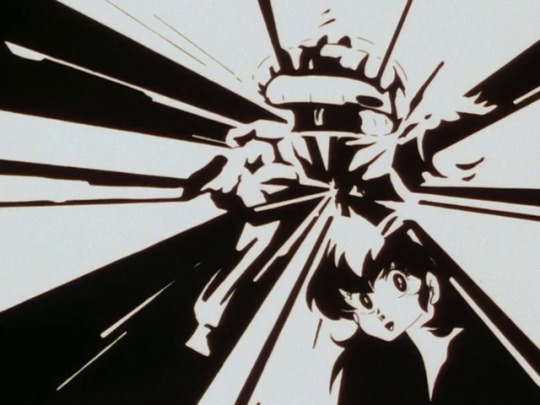
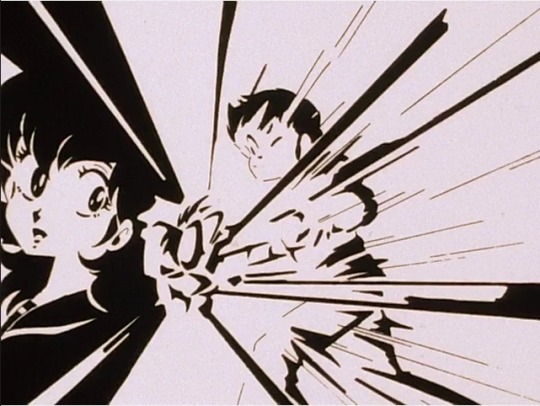
Some of his impact frames.
If we take a look at his scene in the PV we see how both characters exchange position relative to the camera, as if the camera is rotating around them as they exchange blows. It reminds of his scene in Outlanders OVA, one of his best overall. Just like a lot of other young animators of that generation, however, he sadly didn’t put out any work worthy of note after the ‘80s, especially after switching his focus to directing and participating in less projects overall.
As for people he works\worked regularly with there was Moriyama Yuuji, a friend of his since the ‘80s. I bet the person who introduced them to each other was Hideaki Anno, since Anno met Moriyama around the year 1984 while the latter was at Studio MIN, which is another small studio located not that far from Graviton. Again, the word “studio” isn’t to be taken at face value here, as MIN was akin to Graviton in being more or less an apartment for animators to work in, hinting at the fact that such studios weren’t all that rare.
MIN was founded in 1982 and dissolved in the year 1991, yet it was full of prolific creators throughout its short lifespan. Other than the aforementioned Moriyama we have Hiroyuki Kitakubo, Hideki Tamura and Yoshiharu Fukushima as the studio’s founders, while Nobuteru Yuuki joined them later on. You’re free to look up any of those names, no short post is enough to cover the career of any single one of them, and this short post has already been dragged beyond its original intended length. As a side note though, I now notice that most of the people behind the infamous Cream Lemon Pop Chaser were either form MIN or from Graviton, and it’s an amazing realisation that a few very young creators in their small apartments created one of the most memorable and striking episodes of the whole ‘80s.
Before I end this post I’ll add that the period in which Anno met Moriyama was when Moriyama was working on a manga by Mamoru Oshii (the acquaintance between them goes back to when Moriyama worked on Urusei Yatsura). The manga was named “In The End... “ (とどのつまり) and was published (or was to be published?) in a sub-magazine from Animage called Animage Comics (アニメージュコミックス). That caused Toshio Suzuki, who was still an editor at Animage, to visit MIN regularly and run into Anno, whom he probably knew due to his participation in Nausicaa 2 years prior.
8 notes
·
View notes
Text
Anime Shows I Have Seen (Including Those I Have Not Completed Yet); And Anime Shows I Am Considering Seeing
I became very interested in original anime (but especially Mecha anime) ever since I discovered Beast King Golion; the first time I came across original anime was when I noticed someone watching a Sailor Moon clip in English subtitles rather than being dubbed in English. Because of this, I then became curious, and started to explore the animated genre. Now, I have been searching for more shows of the Mecha genre (or even the regular Shounen genre) that I may like (or may not, depending on the quality, production, plot, voice acting, animation, and/or the execution of the premise) and add to my favorite work list in the future.
Here are the following anime shows (original with subtitles) I have seen from the first (other than a brief Sailor Moon video) to the most recent, starting with the shows I have completed:
- Transformers: Micron Legend
- Transformers: Superlink
- Brave Police J-Decker
Now with the shows that I watched, but have not yet completed:
- Beast King Golion
- Sonic X
- Yu-Gi-Oh! Duel Monsters GX
Here are the following anime shows I have not seen yet, but I am considering seeing at some point in the future:
- Brave Exkaiser
- Brave Fighter Of Sun Fighbird
- Brave Fighter Of Legend Da-Garn
- Brave Express Might Gaine
- Brave Of Gold Goldran
- Brave Command Dagwon
- GaoGaiGar
- Armored Fleet Dairugger XV*
- Lightspeed Electroid Albegas
- Star Musketeer Bismarck
- Transformers: Car Robots
- Transformers: Headmasters*
- Transformers: Super-God Masterforce
- Transformers: Victory
- Super Dimension Fortress Macross
- Super Dimension Cavalry Southern Cross
- Genesis Climber Mospeada
- Raideen The Brave*
- Raideen The Superior*
- Neon Genesis Evanglion
- Magic Knight Rayearth
- The Vision Of Escaflowne
- Super Electromagnetic Robot Combattler V
- Super Electromagnetic Machine Voltes V
- Fighting General Daimos
- Dai-Guard
- Mobile Police Patlabor
- Tengen Toppa Gurren Lagann
- Mighty Orbots
- Space Runaway Ideon
- Getter Robo
- Metal Armor Dragonar
- Any Gundam series that is not too well-known by fans
*Note: seeing a few clips or even parts of the show does not count as actually having watched the show; to have seen the show, I must watch at least one whole episode from it
Most of the anime shows I liked, completed, or want to see later contain Mecha robots that are in the Super Robot category, especially those that remind me more of Transformers, the first giant robot franchise I ever saw and really like a lot; bonus points if the Mecha robots are sentient like the Transformers and/or even pilot their own Mecha robots!
If you like, feel free to add other suggestions for anime shows that I can watch that I have not listed, yet. Otherwise, I will leave it at that until I find something that further catches my interest.
#anime shows#anime#list of anime#list of anime shows#list of anime shows I am considering watching at some point in the future#list of mecha anime#list of shounen/mecha anime shows#list of animated shows with giant robots other than transformers#that said there is no guarantee that some of the shows I listed are any good even though they are mecha shows#most of the anime shows I have watched and then completed or want to watch happen to be mecha shows#I may make another post talking about tropes and other traits that I look forward to in an idea mecha series#super robot and real robot shows#I am personally more of a super robot person but I can like some real robot shows as well#are there shows that are a crossover of a super robot and a real robot genre?#I put 'transformers: car robots' above 'transformers: headmasters' since I took a recent interest in the former#if there is anything I may have missed feel free to add more shows for me to watch later#list of anime shows to watch later#list of animated shows to watch later#list of shows I have been wanting to see#the more underrated overlooked or lesser-known the show is the more interested I am in watching it
2 notes
·
View notes
Text
Happy Birthday, Space Cowboy: A Shinichiro Watanabe Retrospective
Today we wish a very happy birthday to the Cowboy Bebop director, the one and only Shinichiro Watanabe! Watanabe-san has been a powerhouse in the world of anime for well over two decades, working with acclaimed studios such as Sunrise Inc., Studio Nue, and BONES. His mastery at blending Western and Eastern elements has earned Watanabe a devoted fanbase in many different countries. One of the most consistent aspects of Watanabe's catalog is his skill at successfully amalgamating a variety of genres from sci-fi to Westerns to comedy and more.
In honor of Watanabe's birthday, I'll be exploring the artistic depth of three anime from his impressive oeuvre and celebrating the very special spark that can be found in all his works. Read on for more!
Terror in Resonance (2014)
Terror in Resonance seems critically underappreciated when compared to some of Watanabe's other directorial efforts. Though it lacks the robust character development and sense of immersion found in his other titles, the series still retains many of the qualities that make Watanabe such a globally respected anime auteur.
Terror in Resonance follows two high-school-aged terrorists named Twelve and Nine as they plot a series of bombings in order to reveal the injustices enacted against them — and many other children — during a secret government operation called the Athena Plan. Along the way, a lonely girl named Lisa finds herself enwrapped in the boys' mission, and experiences camaraderie for the first time due to their presence.
The show's basic premise alone reflects Watanabe's willingness to explore uncommon thematic spaces by featuring literal terrorists as two of the main characters. Common in his other works as well, Watanabe invites viewers to feel compassion for characters who inhabit the outermost margins of societal acceptability. The show doesn't endorse Twelve and Nine's actions, but it does position them as isolated characters with real human attributes, acting coherently in retaliation to the incorrigible exploitation they faced as children. Twelve and Nine also make extreme efforts to make sure no one is killed due to their bombings, which serves as an empathetic deviation from standard depictions of terrorists as one-sided, monstrous caricatures.
Ultimately, Terror in Resonance features many trademarks of Watanabe's unique touch: compassionate explorations of loneliness, a tragic narrative interspersed with brief moments of beauty, and yet another gorgeous soundtrack by Yoko Kanno (a frequent collaborator with Watanabe).
Macross Plus (1995)
Watanabe made his directorial debut as co-director for Macross Plus working alongside Shoji Kawamori (the creator of the original Macross). This four-part OVA is the best flying mech, artifcial-intelligence-pop-music-gone-horribly-wrong redo of Top Gun I've ever seen. I remember I first saw it on the Starz Channel back in 2002 or 2003. It was fun to revisit the US dub recently with the fresh realization that Bryan Cranston — aka Walter White, our favorite fictional suburban meth dealer — did the voice acting for the main character Isamu. Isamu is like a more womanizing Spike from Cowboy Bebop, mixed with the arrogance of Mugen from Samurai Champloo, and is an early example of a recurrent protagonist-archetype in Watanabe's titles. The playful comedic qualities Watanabe would become known for were already apparent in much of Macross Plus, such as the scene when Isamu and his rival Bowman bring up old adolescent/high-school gripes while they're both engaged in an airborne mech-duel to the death.
Once again, Yoko Kanno's absolutely incredible score must be mentioned. The soundtrack ranges from orchestral music perfect for dogfights to emotional ballads and '90s trance (there's also a really cool reference to the Aphex Twin album "Selected Ambient Works 85-92" on a bus sign in one scene). Watanabe's first directorial outing already grapples with a subject near and dear to his heart: music. The last episode features an intense sequence involving an AI popstar named Sharon Apple, who takes control of everyone viewing her concert via seductive musical mind control. This scene explores a what-if scenario: an imagined future where technology meshes with the power of music for nefarious — rather than healing — ends. Either way, since Watanabe is a self-proclaimed "music freak," it's fun to watch him implement a plot device about just how disruptively powerful music can be (his most recent anime Carole and Tuesday tackles AI and pop music with a more neutral lens, as an FYI). Macross Plus is not to be missed.
Cowboy Bebop (1998)
I'll never forget what it was like to experience Cowboy Bebop for the very first time when it initially aired on Adult Swim in 2001. I must have been 12 or 13 at the time, and few pieces of media have made such a lasting impression on me. I was already extremely impressed even after seeing the first episode "Asteroid Blues," but it's the fifth episode entitled "Ballad of Fallen Angels" — where viewers are introduced for the first time to the central antagonist Vicious — that completely sold me on the series.
"Ballad of Fallen Angels" culminates in a climactic battle that takes place in a church, with the main character Spike duking it out against Vicious and his goons. The most memorable moment for me is the scene when Spike is thrown out of the top of the church by Vicious. Spike falls in slow-motion as viewers are treated to a montage of his tragic crime syndicate past and his relationship with his lost love Julia. It's such a stunning moment that perfectly echoes the old creative writing adage "show don't tell," since it subtly expresses so much about Spike's life without explicitly battering it over your head. The scene speaks volumes in just a few wordless seconds, with no sounds to be heard at all other than Yoko Kanno's gorgeous choir and piano-based track "Green Bird." I've drifted toward arthouse movies as I've grown older, and I truly think the aforementioned scene was my first time experiencing the ineffable artfulness that I find in the experimental films that move me most. It feels a little silly and overblown to say, but the sequence feels like it contains a large spectrum of life — love, hate, sadness, memories, dreams, etc.
Cowboy Bebop is a show that abounds with moments like this. There are so many moving scenes rich in an atmospheric tenderness that aches with longing, loneliness, and beauty. Intimate scenes where characters in interstellar ships stare quietly at a sea of stars. A view of someone smoking a cigarette alone in a dimly lit alleyway. Or something like the ending of "Waltz for Venus," when a music box-esque song plays while Spike gazes into the sky as spores that can blind drift downward like snow.
I could go on and on about the series — the masterful quality of Keiko Nobumoto's screenplay, the riveting action sequences and lovable characters, the expert blend of genres coupled with breathtaking animation and music, and how Spike's somewhat Buddhist philosophy (whatever happens, happens) influenced my own. Cowboy Bebop truly deserves all the praise and is undoubtedly one of the best animated works of all time.
So here's to you Shinichiro Watanabe. I hope you have a birthday as stunning and cool as the anime you've graced the world with.
What else do you love by Shinichiro Watanabe, and why? Sounds off in the comments below!
Do you love anime? Do you love writing? If you have an idea for a features story, pitch it to Crunchyroll Features!
2 notes
·
View notes
Text
Planet With: Final Thoughts
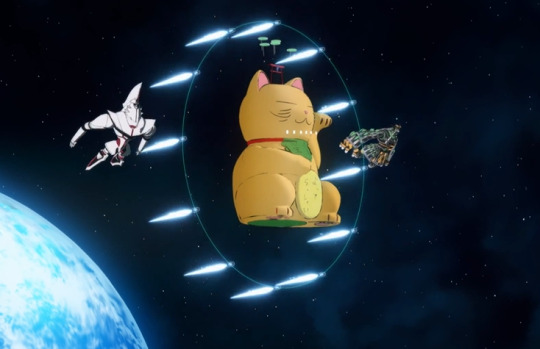
That was a short series, but probably one of the most memorable I’ve seen any time recently, which is a pretty solid achievement given that I watched it right after another very memorable series in the form of Macross 7. Planet With’s bizarre and zany presentation betrays a surprisingly solid plot with likeable characters that’s delivered at a satisfying pace given the short 12-episode run it had.
It’s tricky to go into that plot without going too hard into spoiler territory, but just the first episode was enough to grasp my attention in a big way. The setup that’s delivered is that Soya Kuroi is a highschooler with amnesia who lives with Ginko, a gothic lolita girl, and a giant cat who only goes by the name Sensei. One day, a giant floating object sent by an alien force called Nebula appears over the ocean, only to be taken down by a team of seven superhero-like figures who create giant suits of psychically-powered armour. It’s then that Ginko and Sensei give Soya a new mission - not to help the heroes, but to defeat them one by one and take their power in order to accomplish Nebula’s goals. To accomplish this, Sensei will swallow Soya whole, which triggers a psychic reaction to create a cat-shaped suit of psycho-armour. So yeah, a completely normal day for a highschooler.
It’s a lot to take in and is portrayed in a baffling manner but the story does an incredible job of weaving all the insane elements of its presentation into something that’s only coherent, but actually pretty compelling. Despite the short length of the series, it’s basically a non-stop rush of strong character development for pretty much every named character, while the events that transpire span far wider than might first be apparent. It’s probably one of my favourite stories I can think of - I really liked the characters and how they interact with each other, the general pace of the plot, the individual beats of the story, and I also really liked the themes that it strikes upon - I kind of wish I could say more, but I honestly feel like giving too much away would be a disservice to whoever decides to watch it.
While this is definitely more of a plot-heavy series than one focused on raw action, it was definitely plenty satisfying on that front too. The show does use 3D animation for its mecha, which will probably turn some people off, but at the same time it’s about as good looking as I’ve seen in a mecha series. Besides, that’s made up for by the strength of the mechanical designs. I never caught a name for the cat-shaped robot that Sensei turns into (in fact, “Sensei” is probably the aptest thing to call it - or rather, him) but speaking as someone who doesn’t typically go for the kind of big-head, somewhat super-deformed style of robots I thought it looked incredible, as do the two upgrades it gets. The other psycho-armours that appear over the course of the show are similarly well realised. That said, the action was probably the biggest casualty of the short runtime and is probably the one thing I wish there was more of in the show. Elsewhere on the presentation front, I thought the soundtrack was fine and the animation quality was solid - it’s pretty much right on par for modern anime.
Overall this was a really pleasant surprise and is definitely one of the most unique series I’ve seen in quite some time. The fact that this only came out last year only goes against the reports of naysayers who says this genre is dead, as its shows there’s plenty of potential still here both for quality and for truly original ideas. I do kind of wish the series could have been longer, but its short length also makes it easier to recommend as it’s less of a commitment than something longer. The general weirdness of its aesthetic might turn some people off but I really do think this is worth giving a chance at the very least.
19 notes
·
View notes
Text
I Need You: Why Evangelion Still Matters

If you’re even a casual fan of Japanese animation (colloquially known as anime) you’ve probably heard of a few classics held up as the best of the medium; films and television shows whose place in the history of Japanese culture is widely regarded as secure: Akira, Cowboy Bebop, Ghost in the Shell, Spirited Away, to name a few of the most prominent. They all have their critics, but few would dispute their place as landmarks of the industry. But there’s one classic piece of Japanese animation however whose legacy is far more contentious and which sparks controversy even today. Like the aforementioned pieces it’s well-known and has been watched by many, but unlike them it remains quite controversial, beloved by some and derided by others.
I’m talking about Neon Genesis Evangelion,¹ Hideaki Anno’s 1995 post-apocalyptic series about teenagers who pilot giant robots (known as mecha) in a war for the survival of humanity. And in my opinion it’s actually one of the best and most important television shows of all time, animated or not.
(Spoilers ahead, though I’ll try to keep major revelations to a minimum.)
I realize that in making my claim, I’m setting myself up for criticism. The value (or lack thereof) of Neon Genesis Evangelion has been one of the most heated debates in anime fandom for decades. But even on the purely objective level of its influence on the animation industry, both in Japan and beyond, NGE and its subsequent spin-offs, sequels, and re-imaginings is a significant work worth consideration. Although the show is decades old now (the first episode aired October 4, 1995), I believe it’s still worth examining why the show’s so acclaimed and why, in my opinion, it’s still relevant today, in no smal part because of the lessons it still has to teach us about self-acceptance.
(An earlier version of this essay was posted 4 years ago here.)
Weaving a Story
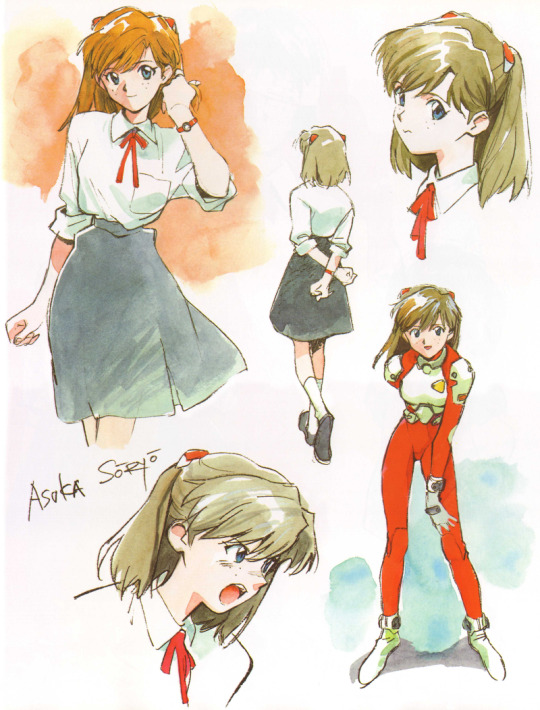
Concept art for Asuka Langley Soryu, the Second Child
Today, Evangelion is a major franchise, incorporating films, comics, video games, and more. But it all started with one TV show, Neon Genesis Evangelion, created by Hideaki Anno for Gainax. Even from the start, NGE was somewhat exceptional. In the early-to-mid 1990s when it was produced, most of the major animated shows on air (both in Japan and America) were heavily merchandise-driven and sponsored by either toy or video game companies. Nearly all were owned by a major studio like Toei or Toho. Conceived of by a single individual and owned by a small creator-run studio, Neon Genesis Evangelion was highly unusual and something of a creative risk.
The story of Neon Genesis Evangelion is, on first glance, nothing remarkable for Japanese animation. A group of teenagers are recruited by a unified global government to pilot giant robots (mecha) in a battle for the survival of humanity. In the process they have to face not only their deadly adversaries but also learn how to work together as a team, overcoming their many differences and personal issues. Gundam, Macross, and Hideaki Anno’s own Gunbuster had all covered similar territory before. But where NGE would go with its premise was far stranger, blending the well-tread concept of adolescent soldiers with theological imagery, Freudian and Lacanian analysis, and abstract writing that soon set the show apart from its contemporaries.
The show quickly caught the fascination of viewers. While Neon Genesis Evangelion started initially with solid but unexceptional ratings, it soon expanded into a massive pop cultural phenomenon as more and more people tuned in to find out what all the fuss was about, eventually reaching 25-30% of the targeted demographic.² The final two episodes, noted for their abstract nature and for seemingly leaving several plot threads hanging, prompted a highly polarized reaction. The follow-up movie The End of Evangelion, released a year later, divided audiences even further. As a consequence, despite Evangelion’s immense popularity and influence, the franchise remains one of the most controversial works to ever air on broadcast television.
Neon Genesis Evangelion’s ending was, however, just one of its controversial aspects. Moral guardians raised complaints about the show’s frank (and frequently bleak) depictions of sex, violence, and mental illness, demanding networks censor its content. Critics such as Eiji Otsuka and Tetsuya Miyazaki accused Anno of “brainwashing” his audience and affirming, rather than criticizing, anime fans’ escapist tendencies. Yoshiyuki Tomino, the director of both Gundam and Ideon, complained that Anno tried “to convince the audience to admit that everybody is sick” and that it “told people it was okay to be depressed.” Additionally, much was made of the show’s religious imagery, particularly due to the then recent sarin gas attacks by the Aum Shinrikyo cult, which like NGE utilized a blend of Western and Japanese religious imagery.
Other complaints centered on NGE’s main characters, many of whom were found to be unlikeable or unheroic. Many attacked the lead protagonist Shinji as weak and indecisive, unbecoming of the hero in a show aimed at adolescents. Some further asserted the character was an attack on the show’s audience and that Anno wanted to “punish” his audience for their anime-loving ways. The rest of the cast didn’t escape criticism either and were variably found to be cruel, schizophrenic, or perverse. All could easily be characterized as dysfunctional.
But despite the backlash against Neon Genesis Evangelion, whether it was centered on the show’s ending, its thematic elements, or its characters’ deficiencies, none of it seemed to put a lasting dent in the show’s influence or popularity. And a lot of that, perhaps, has to do with the time in which it emerged. At the time NGE was originally produced in the early to mid 1990s, Japan was in the midst of an extended economic downturn that would come to be known as the Lost Decade, following a major asset price crash in 1989. During this time, Japanese animation, like many industries, experienced a contraction, resulting in slashed budgets and an increasing reliance on merchandising and product placement to sustain both the studios producing the content and the major networks who broadcasted (and often owned) it.
In addition to these economic concerns, there was also a growing feeling in the 1990s that animation was a thing of the past, whose glory days were long gone and which only inspired passion in either adolescents or callow, sheltered men in their 20s or 30s. The content of most anime was regarded as puerile or derivative and hardly becoming of serious adult interest. The term otaku,³ a word that literally means “house” but was used to mean “shut-in,” quickly became shorthand for anime fans who spent their adulthood collecting memorabilia and memorizing lines from their favorite shows.
But Neon Genesis Evangelion helped to change all that and to reclaim anime’s respectability. Breaking through the traditional animation fandom to a wider audience and owned solely by the creator-run Gainax, NGE was an invigorating shock to the industry, shaking it up and reviving interest in what had been regarded as a dying medium. Within a few short years, new creator-owned studios were cropping up across Japan, a trend which would continue well into the next decade and bear such fruit as Bones, manglobe, Ufotable, or Gainax’s own offshoots Trigger and Khara. The animation industry was expanding again and was beginning to boom overseas, in no small part thanks to the popularity and notoriety of NGE.
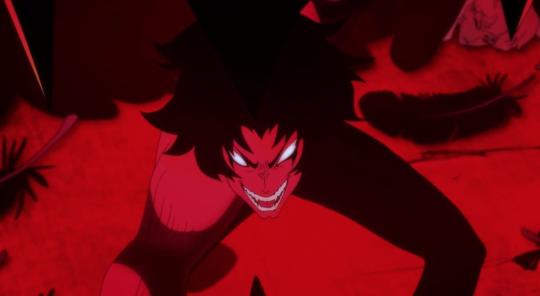
Devilman: Crybaby by Science Saru, a series itself based on one of Evangelion’s chief influences
The new anime boom would also reflect its origins in a number of different ways. More than a few of the new shows to debut in the late 1990s and early 2000s were directly influenced and impacted by Neon Genesis Evangelion, including such notables as RahXephon and Revolutionary Girl Utena. More subtly, the starkly realistic depictions of violence and sexuality in NGE as well as its bizarrely surreal imagery encouraged many directors to try similar techniques, resulting in a shift in style throughout the industry.
Neon Genesis Evangelion’s influence on later anime can be attributed in some ways to its technical sophistication. At its most basic, visceral level, NGE was startling to look at. Even compared with other Gainax works that had come before it, like Nadia: The Secret of Blue Water or Gunbuster, NGE immediately stood out as something unique in an increasingly homogeneous industry. The character designs of Yoshiyuki Sadamoto, strangely subdued yet striking and expressive, helped distinguish the cast while Ikuto Yamashita’s monstrous and biomechanical designs for the Evangelions did the same for the show’s mechs. Combined with the intense direction of Hideaki Anno, Kazuya Tsurumaki, Masayuki, and others NGE drew the eye right from the start.
The technical splendor wasn’t just limited to NGE’s art design or animation either. The voice talents provided by performers like Megumi Ogata, Kotono Mitsuishi, Megumi Hayashibara, and Yuko Miyamura gave life to the characters and helped audiences empathize with them, despite their dysfunctional and emotionally-wrought nature. Also contributing to the audio portion of Neon Genesis Evangelion was Shiro Sagisu, whose music swung significantly from jazzy to melodramatic and even to surreal, changing and evolving to match each scene with an appropriate mood. Assisting Sagisu was the vocal work of artists such as Yoko Takahashi, who made the show’s central theme, “A Cruel Angel’s Thesis,” a pop sensation.
But while the technical triumphs of Neon Genesis Evangelion certainly contributed to the show’s lasting appeal and influence, they’re hardly the whole story. For many viewers, the appeal of Evangelion went well beyond the surface, to narrative and thematic elements they felt spoke directly to them. Indeed, it is arguably NGE’s complex characterization, unorthodox narrative structure, and thematic depth which have made it stand out as one of the most legendary examples of Japanese pop culture.
A Cruel Angel’s Thesis
It’s not an exaggeration to say that essays—and books—have been written about Neon Genesis Evangelion and its thematic qualities. Most of this has been concentrated in Evangelion’s own native Japan, but the sensation has breached the other side of the Pacific as well, resulting in comparisons to the works of David Lynch and other Western directors. Contributing to this no doubt has been Anno’s own numerous references in NGE not only to native Japanese culture but to the West as well, with tributes to works like 2001: A Space Odyssey, The Andromeda Strain, and UFO found frequently throughout.
The most obvious thematic element present in Evangelion, at least to Western eyes, is its frequent allusions to Christianity, Judaism, and Islam. It’s not hard to see why: the monstrous foes besetting humanity are “Angels” who shoot cross-shaped energy bolts, which the main characters fight with “Evangelions” (the Greek word from which “evangelism” derives). Coupled with other bits and pieces here and there referring to original sin, the will of God, and ancient Judaism, these details give Evangelion a strikingly religious appearance to Western viewers.
However, while they’re certainly the most obvious elements in Evangelion, the religious references are also easily some of the most transient and insubstantial. Although initially viewed as central to the plot by many Westerners, it has since been revealed that most of the Biblical references are there for styling rather than substance and were largely intended to make the show stand out. In many respects, the usage of the Abrahamic faiths in Evangelion is similar to the use of Buddhism in The Matrix or Egyptian mythology in Stargate: a bit of fun exoticism to keep things interesting.
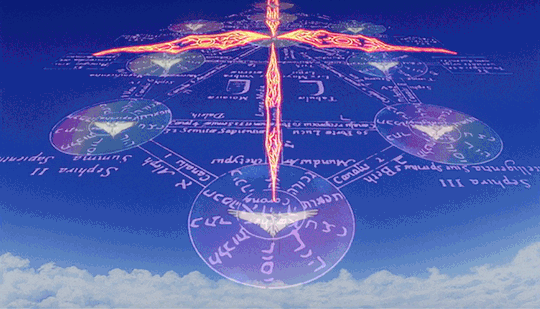
The Sephirot from Kabbalah, as represented in The End of Evangelion
That being said, the religious themes are not as vacuous as is sometimes alleged and the sheer number and obscurity of some of them indicates some real effort on the part of Anno. Each of the Angels, for instance, (which are called shito⁴ in Japanese, meaning “messenger” or “apostle”) are named after actual angels from Abrahamic mythology and their names, when translated from Hebrew or Arabic, often do indicate their nature in some way (e.g., Arael’s name means the “light of God” and it is an enormous winged being who attacks the characters with a beam of light). And while the use of the Kabbalah’s Sephiroth may be perfunctory, many other references to Jewish mysticism appear more meaningful, such as the Chamber of Guf or the duality of the Trees of Life and Wisdom.
Less obvious to Western eyes but possibly even more sophisticated are the references Evangelion makes to non-Abrahamic religions. There is, for example, the notable similarity between what the show terms “Instrumentality” and traditional descriptions of “egoless” nirvana in Buddhism (a religion also referenced by way of the Marduk Institute’s 108 dummy corporations).⁵ Japan’s native religion Shinto also shows its hand, most notably through the depiction of the Evangelions themselves, which Anno consciously designed after the monstrous oni of Japanese legend. All in all, while he may not have intended to portray a particular theological message, it’s clear that Anno put a lot of thought and research into giving Evangelion a suitably mystical appearance.
However, obsessing over the religious imagery in Evangelion obfuscates something far more important: Evangelion isn’t really about religion. Rather, where Evangelion’s thematic depth and complexity most clearly comes into play is psychology and philosophy of the mind.
Neon Genesis Evangelion is often described as a deconstruction of mecha anime. To a large extent that’s true, but it’s deconstruction is specific in outlook, focused on the psychology of its characters in the form of a question: just what kind of people would put the fate of humanity in the hands of adolescent children? And just what would that kind of stress and responsibility do to a child’s mind? In that regard, NGE is in far closer in kinship to Ender’s Game than to its natural predecessors like Macross, Gundam, or Gunbuster.
When the story of Neon Genesis Evangeliom begins, the world has already experienced disaster on an unprecedented scale. 14 years before the show begins, a massive apocalyptic event called the Second Impact devastated the Earth’s climate, precipitated global nuclear war, awakened the monstrous Angels, and resulted in the deaths of half of all humans on the planet. In response, civilization has been restructured and militarized in anticipation of an even worse Third Impact threatened by the Angels. To combat this threat, the secretive organization Nerv assembles biomechanical monsters of their own (the Evangelions) which, as it so happens, can only be piloted by teenagers.⁶
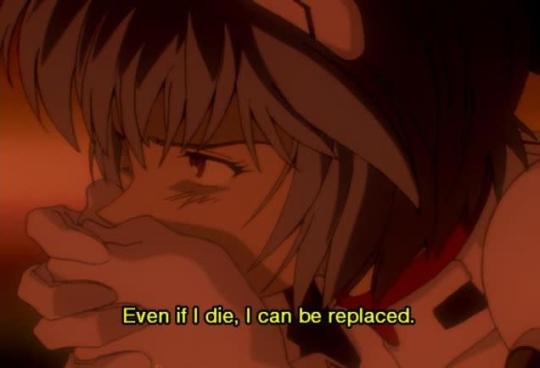
Rei Ayanami, the First Child, believes that her life is expendable
This is the kind of world people like Misato Katsuragi, Gendo Ikari, and Ritsuko Akagi live in and it’s the severity of their situation which ultimately shapes their actions. Although many of the adults, particularly Misato, wish they could let the series’ child protagonists lead a normal life, they know that’s not an option. As a result, the adult characters are driven towards a cold pragmatism that means, no matter how warm or compassionate they may act towards their wards at any given time, they’re still ready to sacrifice them when necessary.
This ruthless approach has its costs, however. The constant pressure to succeed, alongside the emotional whiplash they receive at the hands of the pilots’ supervisors and the repeated trauma they experience in combat results in each pilot’s gradual psychological degradation. Beginning as relatively competent and capable (if slightly dysfunctional) individuals, each pilot eventually succumbs to their trauma and breaks, causing them to isolate themselves from one another and resulting in a breakdown in morale which puts not only themselves but humanity itself at risk.
In keeping with this theme of psychological frailty and the ways in which we as people both intentionally and unintentionally harm those we care about, including those we care about, the series makes numerous allusions to the work of past psychologists and philosophers. Many concepts are mentioned specifically by name, such as the “oral stage,” “separation anxiety,” or the “hedgehog’s dilemma,” while others are alluded to more subtly, such as the Oedipus and Elektra complexes, post-traumatic stress disorder, schizophrenia, or Lacan’s dichotomy of the constructed and ideal selves.
Hideaki Anno has himself said he researched psychology both before and during the production of Neon Genesis Evangelion and that many of the show’s characters are based upon both these concepts and his own experiences. He has, for instance, described the protagonist Shinji as a reflection of his own conscious self, while the emotionally withdrawn Rei is a manifestation of his unconscious, and the enigmatic Kaworu is his Jungian shadow. Altogether, the works of Freud, Lacan, Schopenhauer, Hegel, Jung, and Sartre have all been identified by staff or critics as influences on the show’s characters and plot.
One of the chief psychological themes in Evangelion is abandonment, particularly by those you love or have been cared for by. Throughout the story—in its past, present, and future—each of the main characters is abandoned by people important to them: their parents, their guardians, their lovers, their friends, etc. Invariably, this abandonment leads to a breakdown in identity and self-confidence, as each character is forced to redefine themselves from within after devoting so much of their identity to how they were perceived by others. Thematically matching to this issue of personal abandonment is humanity’s own abandonment by their unknowable creator eons ago, a detail alluded to occasionally as the story progresses. Like the individual characters then, humanity must learn how to manage and master its own fate when it has no one left to depend upon.
The Hedgehog’s Dilemma
These themes, however, would have little resonance were they irrelevant to the show’s human drama. It is to Neon Genesis Evangelion’s credit that they are not; each of the characters represent the show’s themes in both significant and personal ways. It is quite arguable then that it is the show’s protagonists, however controversial they may be either as individuals or an ensemble, which have truly allowed NGE to endure for decades as an icon of Japanese pop culture.
The most important of Neon Genesis Evangelion’s characters by far is easily Shinji Ikari, the pilot of Evangelion Unit-01 and the son of Gendo Ikari, the enigmatic director of the Evangelion program. At the beginning of the series Shinji is called to Nerv by his father, who abandoned him years earlier following the death of Shinji’s mother. Shinji hopes that this sudden call is for the purpose of reunion, but he is quickly disillusioned when his father reveals to him that he needs Shinji to pilot one of the monstrous Evangelions he’s built—a machine Shinji has hitherto never heard of—and to save humanity from extinction. Brokenhearted by his father’s coldness and terrified of the task he’s been blackmailed into performing, Shinji puts off his own desires and self-identity aside for the sake of pleasing his father and others, becoming the so-called Third Child.

Series protagonist Shinji Ikari, the Third Child
Shinji’s a complicated character and one many find difficult to empathize with. He is self-consciously cowardly and phlegmatic, prone to self-criticism, and afraid of getting close to others for fear that they’ll reject him. At times he thinks seriously about running away from his responsibilities, but whenever he actually does he quickly returns, unable to commit to so blatant an act of rebellion for long. Despite this and despite his own reliance on others to define his value, Shinji does have his virtues: he’s thoughtful, easy to get along with, and proves remarkably skilled at piloting, even if he has no real passion for it.
Shinji’s commanding officer, Misato Katsuragi, is NGE’s most prominent adult character and (according to Hideaki Anno) the series’ deuteragonist.⁸ Loud, goofy, and irreverent, Misato strikes quite a different first impression than Shinji, but despite their outward differences they’re actually quite similar people with comparable issues, merely approaching them in different manners. Like Shinji, Misato feels abandoned by her father, who neglected her and her mother before his death years ago. But despite that Misato still yearns for his affection, manifesting her desires in the form of her relationship with Ryoji Kaji, a coworker and lover she admits resembles her father. And, also like Shinji, Misato fears getting close to other people for fear of being hurt, but whereas Shinji manages his anxiety by avoiding people, Misato does so by acting flippant and flirtatious in public, living lightly and maintaining only “surface level relationships.”
Shinji’s move into Misato’s apartment comes largely at her insistence and Shinji is initially quite uncomfortable with it, a feeling which does not subside when he learns she’s an extremely messy housekeeper and an alcoholic. But despite her irreverent personality, Misato turns out to be a deeply caring person who wants very much for Shinji to be happy and, over the course of the series, she tries to direct the development of Shinji as a good parent would, all the while concerned her own flaws make her an unsuitable guardian. Notably, these moments where the two of them bond are some of the most light-hearted in the series.
Although Shinji is the first pilot the series introduces, he is preceded by two others at Nerv. The first, Rei Ayanami, is arguably Neon Genesis Evangelion’s most popular (and certainly influential) character. Enigmatic and asocial to a degree that goes beyond mere awkwardness, Rei lives alone in a desolate apartment she doesn’t even bother to clean, close to no one but her pseudo-guardian Gendo Ikari. Because of her closeness to his father, who has raised her as his own daughter, Shinji initially sees Rei as a replacement for him. It soon becomes apparent however that Rei’s trust and faith in Gendo go well beyond that of a healthy parent-child dynamic. Obedient to a fault and unconcered for her own well-being, Rei causally throws herself into danger for Gendo and Nerv and comes across as emotionless to those around her.
But beneath Rei’s cold, ultra-stoic exterior beats a heart as capable of joy and sorrow as that of any other. Far from the robotic doll many assume her to be, Rei has a secret yearning for others to understand her and her them and, over the course of the series, slowly opens up to Shinji. But although she desires human contact, she doesn’t really know how to initiate it and she’s terrified of the possibility that there’s something about her that makes her fundamentally unlike other people.
Asuka Langley Soryu, the third of the child protagonists to show up,⁷ strikes about as strong a contrast to Rei as one can imagine. Egotistical, loud-mouthed, and possessed of far more bravado than either Shinji or Rei, Asuka joins the cast about a third of the way through the show, after transferring from Nerv’s facility in Germany. Raised since childhood to be a pilot, Asuka prides herself on her skills and looks with disdain on Shinji’s self-deprecating nature and inability to recognize his own accomplishments. Already a college graduate and convinced she’s as much an adult as anyone, Asuka also proves precociously sexual, pining for both Misato’s lover Kaji and, to a lesser but still significant extent, Shinji himself, whom she frequently teases for attention.
Asuka is like Shinji a controversial character; people often look at Asuka and see one of two sides to her: a selfish jerk who bullies Shinji and Rei or an accomplished young woman whose confidence and inner strength makes her the real hero of the show. The truth, however, is that in many ways she’s both. Asuka really is brave—far braver than Shinji or even Rei, who doesn’t really fear death—and she’s definitely skilled. But she’s also prone to jealousy and vindictiveness, as well as a consciously manifested attitude of not caring for anyone. In many ways, however, her bravado is a cover for own insecurity, built upon the belief that no one really likes or loves her.
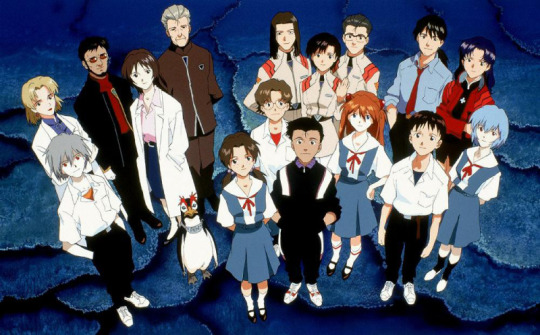
The cast of the original Neon Genesis Evangelion
There’s a lot to admire about NGE’s characters, even with all their flaws and personality disorders. It’s easily got one of the most complex and diverse casts in anime and there has to be something said for the fact that of its four principal characters, three are female, allowing it to easily pass the Bechdel-Wallace Test (which it does). The characters each have their own virtues, which in a more easygoing series could make them quite endearing. Lead protagonist Shinji’s selfless and has a fairly noble streak, though it’s hidden deep beneath his own self-doubt and loathing. The adult Misato’s fairly protective of her young charges, at least insofar as she is allowed to be given the circumstances, and is also quite a bit more capable than many expect. Selfless Rei’s loyalty and discipline easily make her one of the most sympathetic characters in the series, even if she does sometimes come across as alien or inhuman. And there’s little question that the daring Asuka has enough chutzpah for the whole cast.
But it could also be argued that the complexity and harshness of NGE’s characters which ultimately make them work, even if at times they also make the show hard to watch. Shinji, Misato, Rei, and Asuka are not the idealized paragons of humanity you’d expect to find in most television shows aimed at teenagers, but they’re not the imaginings of a bitter misanthrope either. They’re deeply flawed, yes, and when they’re hurt they keep on hurting, but they also keep going and keep trying to find a way to live with others that doesn’t result in pain. It’s this idea, the recognition that people screw up and hurt one another but want to do better, that really enlivens the franchise. For all the reputed darkness of Evangelion’s story, it is in many ways idealistic, always hopeful that it’s characters might find a way to be happy. You don’t have to be broken, it says, even if you are damaged.
And it is that core ethos of qualified hope that elevates Neon Genesis Evangelion from just another mecha anime or even a deconstruction of mecha to something more. Something sublime and, in its own strange way, even inspirational.
The Sickness unto Death
At this point I feel it’s useful to provide some personal background. I first watched Neon Genesis Evangelion when I was in high school, sometime between my third and fourth years. My initial reaction was, I think, largely typical. The first episodes interested me and as the storyline moved forward and became more complex, I became more invested in the show’s events and characters. I even appreciated to some extent the bizarre and abstract final two episodes, though I’d hoped for a more conventional ending. Then, I watched The End of Evangelion, whoch left me shocked and dismayed at its harshness. I still cared about the series, but I felt more ambivalent as a result.
Over the next few years I continued to keep up with the Evangelion fandom to a small extent, checking out the rumors about the new movies and reading some fan fiction online, but I gradually drifted away. None of the fan speculation or fiction really seemed to scratch the same itch the original series had and eventually my interests in anime shifted more towards Ghost in the Shell: Stand Alone Complex and Fullmetal Alchemist. Evangelion, as much as I’d enjoyed it before, fell gradually into the background of my life.
And then I entered college.
In my youth, I was generally regarded as a “bright” student, fawned over by teachers and regarded by my peers as either a genius or a “know-it-all,” depending on how much they liked me (or didn’t). As I entered the final years of high school it was clear that I was expected to excel in university. But when I actually began my college career I quickly faltered. Depressed, socially isolated, and exhausted from getting four to six hours of sleep a night, my grades slipped quickly and my social life evaporated. For awhile, I tried to deny my problems and ignore them, believing I could power through without help. Eventually, though, I had no choice but to confront my issues: I was put on academic suspension and my financial assistance was pulled.
I was devastated. I had no idea what to do. I didn’t know how to tell my parents, who I’d let believe I was doing fine. I didn’t know where to go with my life now that I’d failed to live up to the expectations I’d allowed other people to put on me. I didn’t even really know who I was anymore. If I wasn’t a brilliant student and child genius, who was I? In my own eyes I was worthless and contemptible.
Eventually, with the help of my family and friends, as well as staff from the university, I was able to make my way back to daylight. I began to undertake counseling. I went to community college to bring my GPA back up. I started talking more openly with my loved ones about my problems, even though I was worried it would make them think less of me. And I began to be more honest about my flaws and limitations.
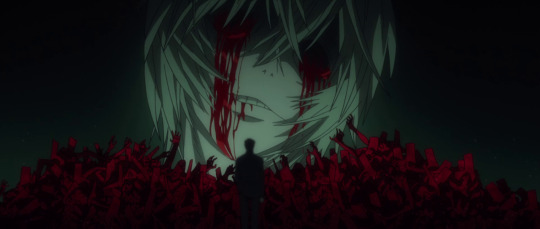
A scene from Evangelion 3.0: You Can (Not) Redo, the third Rebuild film
It was also around this time, rather coincidentally, that I began to seriously revisit Evangelion. I was prompted, as much as by anything else, by the release of the new “Rebuild of Evangelion” films. After my brothers and I attended a screening of the second film’s release in early 2011 with several of our friends, the latter (hitherto unfamiliar with Evangelion) expressed interest in catching up with the franchise. Indulging them, my brothers and I rewatched the original TV series. To my surprise, I began to see the series in a new light. Where once I had simply been sympathetic to Shinji, Misato, Rei, and Asuka’s inner turmoil, now I felt deeply empathetic. Where previously the show’s harshness had at times alienated me, now it felt deeply relatable and truthful. And where earlier the TV show’s decision to focus on the internal psyches of its main characters instead of the plot had puzzled me before, now I felt as if I understood it completely. I even began to appreciate the theatrical finale, a film so brutal some regard it (falsely) as Anno’s revenge against fans angry with him for the original ending.
What had changed? Certainly not the show. Rather, it was my perspective. I possessed now of a viewpoint I hadn’t held earlier. I knew now what it was like to be full of contempt for one’s self, to be a defeated shell of a person who felt as though their value was slipping away or was already entirely absent. I knew what it was like to believe I was a failure in every meaningful way. In other words, I’d gained the perspective of a person suffering from depression. The same perspective as that of Evangelion’s principal characters as well as their creator, Hideaki Anno.
It’s hardly secret knowledge that Hideaki Anno was suffering from depression when he first created Neon Genesis Evangelion. The extent of his depression, however, was far graver than is generally recognized. When Anno began work on the project that would become NGE, he had already been suffering from severe depression for at least four years. In a statement released with the first volume of Evangelion’s manga (comic) adaptation Anno described himself as “a broken man... who ran away for four years, one who was simply not dead.” And while the production of NGE had originally been intended to break him out of a rut, the stress only compounded the severity of his condition. By the time of the show’s completion Anno was, by his own later admission, borderline suicidal.
No one’s ever said precisely what drove Anno over the edge publicly, but it’s widely agreed it had much to do with the production of his previous work, Nadia: The Secret of Blue Water. Originally conceived by Anno’s mentor Hayao Miyazaki in the mid-1980s Nadia was eventually handed off to Anno after Gainax made a bid for the project. Far gentler and family-friendly than NGE, the comparative sweetness of Nadia obscured a troubled production that saw animation work outsourced and Anno frequently butting heads with NHK, the series’ broadcaster, over the show’s content and creative direction. Coupled with rumored trouble in Anno’s personal life, the experience proved too much for him, driving him into the deep depression that would haunt him for most of the 1990s.
The roots of Anno’s emotional troubles may go deeper, however. Long regarded by those close to him as a lonely and eccentric oddball, Anno was socially withdrawn as a child, preferring to spend his time watching and recreating scenes from his favorite anime and tokusatsu to interacting with others, a choice he’d later say he regretted. In 1983, due in large part to his social isolation and inactivity at school, he dropped out of university and lived homeless for a time before he was discovered by Miyazaki and employed as an animator for Nausicaä of the Valley of the Wind. The experience proved vital to his career and soon afterward he and a few friends gathered to form Gainax, their own animation studio. It was during this time that Anno directed Gunbuster alongside working on other projects such as Royal Space Force: The Wings of Honnêamise and Grave of the Fireflies. For a time, he seemed happy. But then came Nadia and he withdrew entirely from his work and social life, before reemerging to work on Evangelion.
Anno’s turbulent life and emotional turmoil is reflected in the characters of Evangelion, many of whom enter the story damaged but apparently functional only to completely fall apart later on. Shinji is lonely and dependent when he first appears, but he still manages to form friendships and do what’s required of him. Misato may be an alcoholic with a mess of a home, but Nerv’s trust in her is rewarded time and time again by her effectual planning and coordination of her pilots. Rei’s cold and emotionally withdrawn, but her dutiful selflessness both inspires and attracts others to her. Asuka can be arrogant and reckless, but she’s also intelligent and capable of real kindness towards those she respects. Like Anno in the early days of Gainax, they all seem to be on top of things.
But just when it seems like the team’s getting the hang of things and finding their groove, disaster strikes. Soon, as one crisis mounts on top of another, from near-death experiences to being forced to hurt his friends, everything falls apart. Shinji’s newfound self-confidence shatters and he becomes even more needy than before. Misato’s constructed domestic bliss blows apart just as her own convictions are thrown into question by new revelations about her work. Rei becomes colder and more distant than ever before, withdrawing even from Gendo, the one person she trusts implicitly. And Asuka collapses into a pit of self-loathing despair, savagely lashing out at anyone who gets close to her. It’s ugly, it’s nasty, and it’s real.
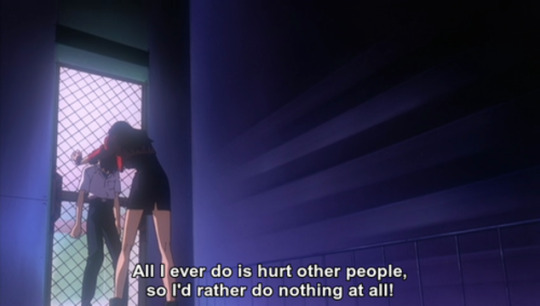
Shinji admits to his feelings of worthlessness to Misato Katsuragi, his guardian and confidante, in The End of Evangelion
This cycle of crash, despair, and recovery is not unusual for suffers of depression. Contrary to what is often thought, depression is not really something you have at one point in your life and then “get over;” it’s something that can shadow you your entire life, kept in check by momentary pleasures and good times but always threatening to surge and overwhelm you when things go awry, sending you into a spiral of self-hate and abnegation that can last for weeks, months, or even years. Friends and family help keep it in check, as does therapy and pharmaceuticals, but it never goes away completely. The only thing you can do is recognize the symptoms and do your best to confront them. You have to keep going. You can’t let your fears drive you to abandon the world. You must not, in other words, run away.
And really that’s what the characters’ struggles in Evangelion come down to: facing reality and acknowledging their flaws while also recognizing their own potential to overcome them and the painful struggle for acceptance we all, on some level, endure. The first instinct of every character in the series is to run away from their problems, to obscure them with outwardly derived duties, relationships, or purposes. Shinji and Rei both look to Gendo, Misato to her job, and Asuka to her pride as an Eva pilot, but all of them are running away and, as a consequence, are unprepared to deal with reality when it hits them flat in the face.
Or are they?
As Long As You Try to Continue to Live
It’s worth noting that when Anno created Neon Genesis Evangelion he didn’t initially set out to create a dark and cynical deconstruction of mecha anime. When asked what initially gave him the impetus to create NGE, Anno has said repeatedly that he originally meant to make a show more in the spirit of Gundam or Space Battleship Yamato, two of his favorite TV shows from his youth, but without the shackles inherent to sponsorship by a toy company, as was common practice for anime at the time. “I made Evangelion to make me happy and to make anime lovers happy,” he said in a 1996 interview, “in trying to bring together the broadest audience possible.”
But as pre-production on the series progressed (and his emotional state regressed) Anno became further disenchanted at the state of anime, concerned that fans were turning to it as a way to escape reality as he himself felt compelled to. “I wonder if a person over the age of twenty who likes robot anime is really happy,” he stated in an article for Newtype half a year before the series aired. This change in perspective, coupled with his resurgent depression, caused Anno to shift focus as he became more and more concerned with the characters’ emotional development, hoping that by the end of the series’ narrative “the heroes would change,” breaking away from their regressed emotional state and achieving the same emotional well-being and self-dependence Anno still sought for himself and which he felt his audience needed as well.
It’s this perspective of Anno’s—that anime otaku were and are caught in a kind of prolonged childhood—which has led to the impression that Anno hates otaku and believes their lives to be worthless. But the truth is that Anno’s thoughts on the subject are quite a bit subtler and more reflective than many give him credit for. Far from hating otaku, Anno counts himself among them and feels defensive whenever they’re derided by others. The issue, he thinks, is less that otaku are permanently stunted and more that they’re afraid or reluctant to open themselves to new experiences:
“I feel that otaku have already become common to all countries. In Europe, in Korea, in Taiwan, in Hong Kong, in America, otaku really do not change. I think that this is amazing. I say critical things towards otaku, but I don’t reject them. I only say that we should take a step back and be self-conscious about these things. I think it’s perfectly fine so long as you act with an awareness of what you are doing, self-conscious and cognizant of the current situation. I’m just not sure it’s a good thing to reach the point where you cut yourself off from society. I don’t understand the greatness of society, either. So I have no intention of going so far as to call for people to give up otaku-like things and become more suited to society. Only, I think there are many other interesting things in the world, and we don’t have to reject them.”
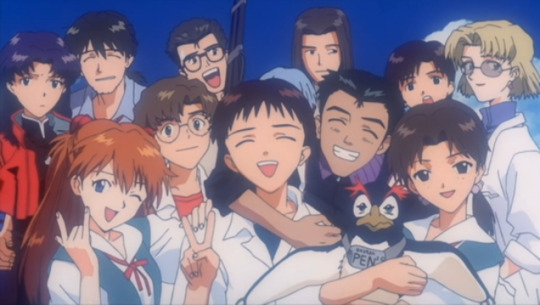
Despite everything, the characters still care for and want to see one another happy
And that’s what I mean by Evangelion’s subtle, qualified idealism. Despite Anno’s frequent cynicism and troubled state of mind during the production of the series, it’s clear that at heart he’s a person who believes people can change and improve themselves. He’s someone who believes that, even in the worst or most desperate of situations, people can find happiness if they’re open to it. “As long as you try to continue to live,” one character states in The End of Evangelion, “any place can be a heaven… there’s a chance to become happy everywhere.”
It would certainly be easy to define the characters of Evangelion by their failures and—given the magnitude of their failures—it’s understandable why many do. After all, much of the series’ narrative is caught up (as I noted earlier) in deconstructing the kind of scenario typical of mecha shows and examing what really would happen if teenagers were put in charge of the world’s salvation. As such, as in other deconstructionist narratives (such as the Battlestar Galactica reboot or Watchmen), the characters screw up about at least as often as they succeed.
That being said, more often than not, when the characters are hit with tragedy or trauma, they eventually recover and bounce back. They’re definitely damaged and shaken by their experiences, but they keep on going anyway. As much as Shinji fears and abhors piloting he’s also someone who, when people are really depending on him, will almost always get right back in the cockpit and try to help. Rei may be over-compliant and lack any regard for herself, but she’s also capable of defying orders when she knows they’re wrong. And for all Asuka’s jealousy and grandstanding, she’s also a person deeply capable of love and self-sacrifice, who would die for those she cares about.
This ray of hope at the core of Evangelion’s story is made most clear in the television series’ original broadcast ending, wherein Shinji rediscovers his own self-value and the joy of living in a world with other people and declares that, although he hates himself, “maybe, maybe I could love myself. Maybe, my life can have a greater value.” But such idealism is even found in the much more outwardly harsh vision of The End of Evangelion. After coming face to face with the world he thought he desired—a world without pain or individuality—Shinji realizes that it’s also a world without happiness. “This isn’t right,” he says. “There was nothing good in the place I ran to, either. After all, I didn’t exist there... which is the same as no one existing.” Realizing this, Shinji chooses to return to the physical world he knew, even if it means feeling pain again.
The idea that joy and pain are in many ways coterminous with one another is hardly original to Evangelion; indeed, it’s a fairly important concept to Buddhism. But I’ve rarely seen the idea expressed in quite the same way as Evangelion, in a way that’s both fully formed and strangely life-affirming. Pain is inevitable, but so is joy. You’ll be hurt, but it’s better than never feeling anything at all and may only give you more appreciation for what you have. You may feel alone, but you’re not; everyone suffers in their life at one point or another, and you don’t have to carry that burden by yourself.
Reflecting upon and considering these themes through Evangelion, as I rediscovered it during a low point in my life, allowed me to appreciate it in a way I’d never been able to before. And it also helped me to move on with my life, to accept the losses I could never recover while also believing it didn’t mean my own life was over. Like Shinji, Misato, Rei, and Asuka, I didn’t have to be defeated by my experiences. I could keep on going. I didn’t have to run away. And that’s a message I believe everyone needs to hear at least once in their life.
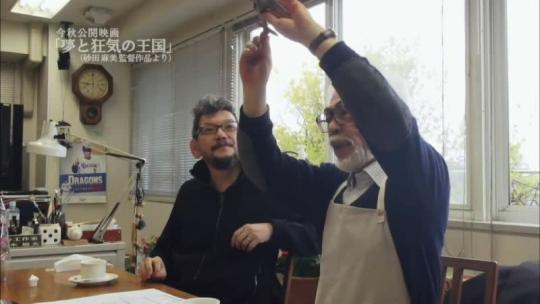
Series creator Hideaki Anno (left) with mentor Hayao Miyazaki (right)
Today, Hideaki Anno has found some peace of mind. He’s happily married, the head of his own production company, and he’s physically healthier too. He still suffers from depression—he’s not cured by any means and he probably never will be; depression isn’t that kind of disease. But he’s able to fight it now and to find the happiness he once believed illusory. He has the same hope he wanted his characters to find in Evangelion. And which I also feel I’ve found, in some small part, thanks to him.
¹Throughout this essay, Neon Genesis Evangelion or NGE refers to the original TV series, The End of Evangelion refers to its theatrical sequel, Rebuild of Evangelion refers to the series of rebooted films produced decades later, and Evangelion on its own refers to the franchise as a whole.
²Specifically, shōnen, meaning boys aged between 12 and 18.
³The term has since been adopted by Western anime fans, but in Japan the word does not necessarily refer to animation fans specifically but to anyone with an obsessive interest in something.
⁴Ironically, “messenger” is a literal translation of the word angelos from Greek—the origin of the English word “angel”—as well as the original Hebrew mal’akh.
⁵The numbers 8 and 108 are both significant in Buddhism. 8 refers to the Noble Eighfold Path to enlightenment. 108 refers to several things, including the number of beads in a Vajrayana prayer rosary, the number of questions asked of the Gautama Buddha in the Lankavatara Sutra, or the number of times Japanese Buddhist temples ring a bell on New Year’s.
⁶The reason for this is never fully explained. Behind the scenes, this was largely because of the show’s target demographic. In universe though it may be related to the secret nature of the Evangelions themselves, which have human souls.
⁷Deuteragonist is a term which means the second-most important character with whom the audience’s sympathies are intended to lie.
⁸Though referred to as the Second Child(ren) because she was the second candidate approved to pilot Evangelions, before Shinji but after Rei.
44 notes
·
View notes
Text
2019 Best Press 3/4: カタカナ・タイトル + Kanji Title by TANUKI

While for many vaporwave vinyl is doubtless equal parts collector’s item and audio source, I don’t want to lose sight of the goal of this blog here: developing a canon of the genre for high fidelity enjoyment. That said, when I come across something remarkable or noteworthy about a particular piece of wax, even if it is not a “purely audiophile” object, I want to make mention of it.
And TANUKI’s カタカナ・タイトル + Kanji Title wax release is not only noteworthy, but contends for hi-fi consideration despite it’s status as a picture disc.
But let’s back up slightly.
Going back to the previous thesis on why we buy records, sometimes you just want to own a vinyl just because. Just because you’re a collector trying to compile a discography on wax — or, better yet, just because you truly love the album art. For me, カタカナ・タイトル + Kanji Title (Double EP) was undoubtedly all of the three “just be-causes”.
A while back, I noticed that the LP was going into its 3rd press, and decided to snap up a copy because I like Tanuki, I like Lum, and because of those other just becauses. Unfortunately the only format available was not the pink vinyl, but the picture disc. As I’m sure is well-known (because audiophiles are very loud about things they dislike), picture-discs are a big no-no in the audiophile community. This is because while a beautiful objet d’art, a serious listening session of a picture disc release will usually produce greater amounts of surface noise than any other type of vinyl. You can, of course, with the right system, neutralize and mitigate this process slightly, but true-blue hi-fi heads pursuing that elusive muse of “pure sound” would never give a picture disc a second look.
I’m not one of those people.
Tangentially, I’ve heard whispers of ghosts of rumors from when I was living in Shenzen, China — that various record suppliers (small batch Makers) are working out manufacturing and material processes that minimize these issues on pic discs to create appealing records that cover all the bases: hi-fi suitability, collector oriented visual esoterica, and price. I should also admit I have no idea where those companies are in terms of R&D and/or producing these. I end up catching a lot of very fast talk from extremely motivated enthusiasts, but Chinese is still as elusive a language to me at times as “pure sound” can be. With that in mind, however, it’s logical to surmise that advances in technology will eventually render the differences between picture discs and traditional black wax undistinguishable. So long as the world isn’t destroyed in some cataclysmic climate disaster (very real possibility), or -- as we are watching evolve now: World War 3. My view is that it’d be pointless to dismiss the format out of hand when there are active attempts to innovate it as we speak.
That all said, I know what to expect when a contemporary, big-label picture disc plays. During my college days, I used to spin wax at the university radio station. One of the previous catalog managers had a fetish for this “collectible” format, and was convinced he was doing the station a favor by purchasing all these vinyls, noting a pre-supposed resale value later. I remember throwing these on the well-worn Technics SP-10 we had as our main turntable, and listening to the occasional scratch, frequent popping, and constant surface noise, that for the uninitiated (bless you), sounds like a sustained “cracking” in your Rice Krispies — or for those born in the analog age, CRTV static.
So when I sat down with the Tanuki picture disc, I had this laundry list of preconceptions and prejudices about the format. I thought that I could listen to a moderately scratchy record once or twice, keep it as more a visual boutique item and then eventually include in an article where I bemoan the poor quality of the genre’s releases.
But then, I actually listened.
And it sounded… well, I won’t get ahead of myself. Here’s the full review:
THE MUSIC
BABYBABYの夢 — is doubtless the reason why many of us have bought the EP from a sonic perspective —especially if the band-camp reviews are indicative of trends. I still maintain that this is the Mariya Takeuchi sample/remix work par excellence. Tanuki hits all the essential notes here, a genuine respect and love for the sound-staging of its original source, Yume No Tsuzuki. I still get echoes of the original arrangement in my system, (ever so slightly) with a bright and dance-infused collection of unique sounds — particularly in that delicious, wide mid-range — that flesh out the track into its own sort of masterpiece.
何がGoin' On — the curatorial and conspiratorial side of my brain tells me that Goin’ On will probably go down as one the under-appreciated vintage bangers of this era of future funk. I can envision hipsters two or three decades from now sussing out a neophyte with pretentious questions about this track’s pitch-shifted sample draws from. It has that sort of vibe that you know hits with a certain subset of electronica fans — rich & vibrant, making the tweeters on your system work out in all the best ways — it’s just great.
がんばれ — Tanuki is at his best when he gets playful with brass samples. I firmly believe that the titans in this genre each have their go-to piece in their best arrangement — like Dan Mason’s creative vocal array, or greyL’s manipulation of micro-samples. For Tanuki, it’s whenever her gets a horn — synthesized or otherwise, into his production workflow.
ファンクOFF — continues Tanuki’s magic act, taking another city pop track more iconic for its soulful electric guitar riff and turning it into the most slap-worthy single on this EP. I prefer it when Japanese pop samples are fundamentally re-imagined, although I can see how the perfectionist tweaking of someone like Yung Bae is more appealing for some. Tanuki is undoubtedly one of the innovators of this genre, and there’s no more solid evidence of that talent than this track.
腕の中でDancin’ — if I ended up hosting a sort of mythical vaporwave grammies or something like that, (I’m available, folks!) I would probably go off on a Ricky Gervais style rant on how artists aren’t in touch with “the people” (read: me) because all we really want are more remixes of Meiko Nakahara songs — who given her impact on City Pop should have way more play in this genre than she does. This one, like most of the Meiko mixes I’ve heard, is a banger with an absolute fire bass riff punctuated throughout.
Radiant Memories — this might be my first certified “hot take” in the publication (they’ll be many more, I imagine) — but as far as I’m concerned this is the superior Plastic Love edit. I’ll just leave my thoughts there, so they can soak in with a portion of the fanbase who split my reddit account on an open fire of downvotes for suggesting that other artists than Macross 82-99 (Praise be upon him!) are allowed to touch this song as well. While Macross’s mix is definitely the more up-temo of the two, and that for some is the very essence of the genre, this slightly down-mixed version is both the perfect conclusion for the EP and ideal antithesis.
THE LISTENING EXPERIENCE
Signal to Raise ratio on the following albums:
カタカナ・タイトル + Kanji Title: ~61.9db (1 db MoE)
Tron Legacy, Daft Punk: 58.4db
Love Trip, Takako Mamiya, Kitty Records Press: 65.8db
(ratings based on averages 5 minutes of sustained play on the testing unit, the machine actually complied this data on its preset, which is another fascinating part about this sort of vintage press-testing tech). The margin of error is because the machine, according to my mentor Dr. Juuso Ottala formerly of Harman International, informs me it was never meant to give accurate readings of picture discs, and to add about a dB of error margin.
One of the benefits of growing up in New England and, subsequently, New York, is that there are no shortage of heritage professional audio brand HQs in operation around a 200 mile radius from Manhattan to Boston. Off the top of my head, there’s Harman/Kardon, Boston Acoustics, Bose, NuMark, Marantz, and Rane headquarters within an hour’s drive from my two hometowns. Early on in my audiophile quest, I got my hands on some cool vintage gear — vinyl lathe testing equipment that has collected dust in both an old Harman technician’s storage unit, and now my parent’s basement. Over the holiday, I recently brought it out to do some surface noise testing on it to get a rough confirmation of what I was explaining in yesterday’s hi-fi guide. The innards of the machine looks eerily like a plinth-less linear tonearm and plate pair attached to a monitor. After making sure I’m not violating some kind of Harman International trade secret, I’ll post it on instagram.
Wanting to also get a firm idea on just how good my ear-test sounded, I grabbed another picture disc vinyl I had received as a gift a few years ago from my brother — the Tron Legacy OST. While I found the film passably enjoyable, my own preconceptions about pic discs, and a general exhaustion with french house — left me with no discernible desire to spin the thing. I hadn’t even broken the seal on the plastic wrap, so it seemed like as good as a blind test as any. I also grabbed what my ears tell me is a “good”, “heavy” press, a 1982 original dead-stock copy of Takako Mamiya’s Love Trip LP pressed by Kitty Records Japan. I’ve played it maybe a half dozen times since I bought it, so it’s as close to “new” 80s audiophile pop record as you can get. The Japanese are infamously anal about low SNR on their vinyl.
And, well, the results speak for themselves. The sweet spot for most black vinyl records is between 60-70db depending on age, weight, and a host of other frankly uncontrollable factors that aren’t worth getting into detail here, as I’d go on forever. The main takeaway here is that Neoncity’s and Tanuki’s record sat at the low end of the audiophile vinyl reference spectrum. Which in itself is a remarkable achievement for a pic disc. It’s worth taking a look at Tron Legacy, which just barely scratches 8db above a cassette tape, and 7db a Japanese vinyl from 1982.
This is all in an effort to say: damn, this is pretty good.
This also somewhat counters the usual “picture discs sound like shit” narrative that’s prevailed pretty consistently in the audiophile community. Tron Legacy? Yeah, that probably sounds like shit if I could bother to suffer through a listen. But whoever Hong-Kong based Neoncity is using actually makes “good” — if such a qualifier needs to be attached — image-pressed records. And that devotion to audio fidelity should be rewarded.
It might be time for me to re-asses picture discs on the whole, and that mind-expanding moment is something I owe to the fine folks at Neoncity.
5 notes
·
View notes
Text
*insert catchy klance meta title here*
IT’S FINALLY HERE. Some of you might have read my post earlier today when I said it was three pages long and how I hadn’t gathered all my screenshots nor explained them yet. Well… Now it’s 14 pages long and I rambled a lot. But here we are.
To contextualize this; I was brainstorming while re-reading various Klance Metas and theories a few days ago (because I’m unsurprisingly thirsty for Klance) and noticed what seems to me to be an important detail that people weirdly enough never focused on as far as I’ve seen. (Remember that it might be an enormous reach)
If you’ve watched New Girl, you’ll probably understand where I’ll be going with this along the line, but for those of you who haven’t, here is a quick summary. (Spoiler Alert, I guess.)
All the way back in 2011 during the first season of New Girl, an episode that Ness (Nick + Jess) fans probably still cherish to this day, came out. If you’re wondering where the fuck I’m going with this and what the hell this has to do with Klance, please don’t give up yet, you’ll see my point.
So, in 1x05, Jess’s best friend, Cece, talks about how if a someone is into you, their feet would point toward you. (“And did you see his feet? A guy’s feet point at what they want. His feet were pointing right at you.”).
Later in the episode, Jess can’t help but look at Nick’s feet, and his feet keeps following her every time she turns around him. Funnily enough, Nick and Jess ends up being the endgame couple of the show. Foreshadowing? Hell yeah baby.
If you’re anything like me, you’re probably thinking “yeah, whatever, it’s probably not true.” Because, that’s exactly what I did think. But with my recent brainstorming, I went looking for answers.
And answers I was given.
Judy Dotton (American Author, graduated from Harvard and all that) did some scientific research about sexual behavior and all the science behind flirting and according to her: “Feet typically point in the direction they want to go, so if someone’s feet are pointed toward you, that’s good. If they’re pointing away from you, that’s bad. If someone’s feet are pointed in toward each other, it’s a good sign, since it’s a subconscious attempt to shrink in size and appear harmless, approachable…which may very well mean someone likes you, a lot.”
And you’re probably there: “CELINE WHERE THE FUCK ARE YOU GOING WITH THIS DAMNIT.”
Well, patience yields focus my little paladudes.
So another source, to go with:
According to Psychology Major Hanan Parvez: “What a person’s foot does can be the most accurate clue of their emotional state. The more distant a body part is from the brain, the less aware we are of its movements and hence the less we are able to manipulate it. So our feet often give away our true feelings […] it is interesting to note that even before the person orient [their] body in the direction [they] want to go, [they] orient [their] foot. That is to say, foot pointing precedes body orientation. Body orientation, prolonged gaze and foot pointing are sure signs that a person is interested in you. They’re literally asking to be approached. […] two people totally interested in each other […] each of them points their one foot forward towards the other person. If only one of them is interested in the other one, you’ll only see one foot stepping forward. Of course, the person who is interested will be the one who assumes this foot forward position.”
Another one for the road, because I’m nothing if not generous:
“The feet serve as a direct reflection of a person’s attitude. The key is recognizing where a person’s feet are pointed. When the feet are pointed directly toward another person, this is a sign of attraction, or at the very least genuine interest. If, on the other hand, the feet are pointed away, or toward the exit, that is a sign that attraction probably is not there.”
Okay, now we’re going to the juicy part.
There’s probably a lot more scenes that could work for my demonstration, but these ones are “big moments” in the relationships and/or personal stories of the characters, so here I am my dudes. I decided to work only with screenshots starting from season 3 up to season 7 (mostly because it’s the only episodes I had on my laptop for reference). You might also want to take into account that fluidity in cartoons and anime is harder, since there’s ultimately less frames, therefore, details such as those can really be more observed in important scenes, where, well every detail is important. But it’s definitely still here. (That’s why I really worked with one on one emotionally charged scenes, or ones with a third intervener.)
Not to jump the boat or anything but Lotura had more one-on-one scenes in the span of two eps than A//urance did in the whole of the show.
Let’s go chronologically until the juiciest of them all, shall we?
Can’t believe I’m saying that, but I’m going to talk about A//urance a lot, in order to, hopefully, shut it down.
Starting with the scene in 3x02 (Red Paladin) where Lance gave the blue bayard to Allura (a scene, that was ultimately cut short by Keith’s actions lzkajea)
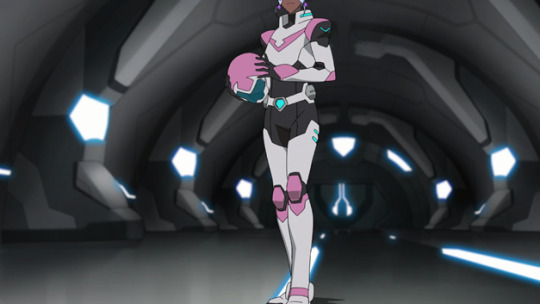
Looking away from blue, Lance notices Allura who just entered the hangar in her new paladin outfit. Where we could have been given Lance’s point of view, like in a lot of scenes having to do with Keith, which would have given, you know, that kind of romantic atmosphere, we’re actually a few steps closer to her and a little on the right. If we look at Allura’s feet, she’s clearly posing in her outfit, but her left foot is pointing at ‘us’, not Lance. Which might be explained by the mentioned fact of her posing. But also, by maybe in fact that she isn’t, at this point in time, attracted in any way to Lance. But moving on to our blue boy:
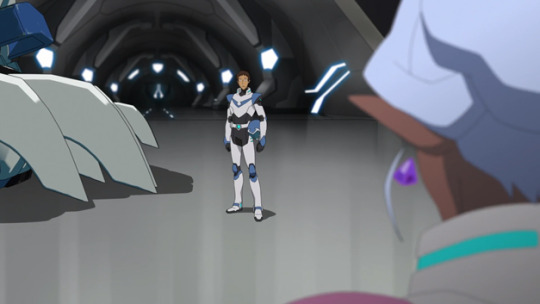
it’s clearly another story. We’re looking over Allura’s shoulder this time, and we know that Lance used to face blue, but he didn’t just turn from the waist up to look at Allura, he turned his whole body, and his foot is pointing at her, not us. We all know Lance has/had feelings for Allura, and genuine ones. This position confirms it.
As early as the beginning of season 5 it takes another turn. Allura is about to get feelings for Lotor in the upcoming future (as season 5 is the first part of the seasons 5+6 arc). We know it now, didn’t know then. But that’s beside the point. When Lance unlocks the Altean Blade, Allura joins him in the training deck. If Lance’s feet aren’t pointing to Allura, it’s only because he’s still assuming a “fighting” position. Allura is not. And her feet are definitely not pointing to Lance.
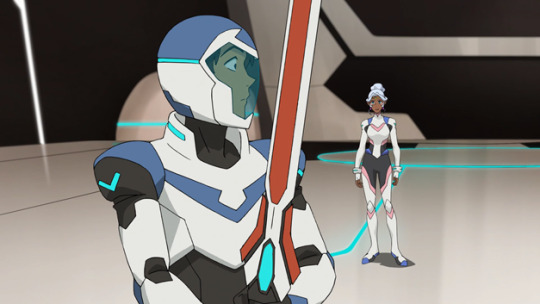
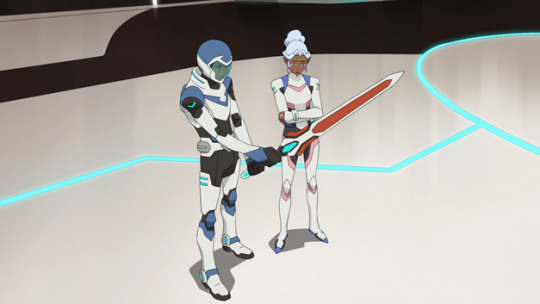
Indeed, as she gets closer to him, her feet are still forming an angle, definitely not pointing to Lance. If you take the time to look at the angle, even if her feet are apart, the overall angle is still mostly narrowed. Now, a few seconds later, she brings her feet closer to each other, and like the following screenshot shows, this movement, made the angle even wider. If we’re going the metaphorical road, we can see this wider angle as somehow a wider gap between them. Maybe the foreshadow of a certain distance, a separation? Moving on?
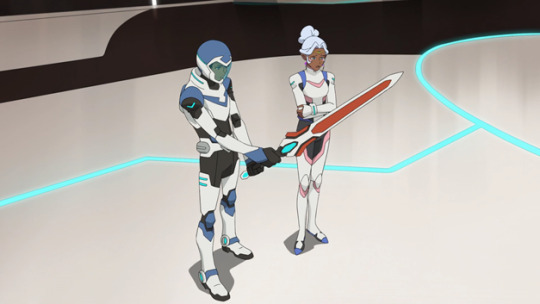
Now. We get to the fun part (nope, sorry, still A//urance, but I promise the Klance talk is coming) as we’re getting closer to the “present” timeline.
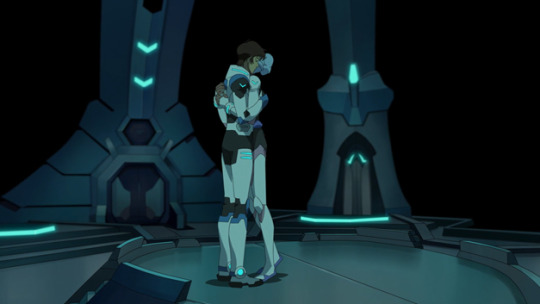
The end of season 6, after the revelation of Lotor’s actions when Allura throw him across the room led to well. That hug. (And my boy Keith interrupting the moment like the amazing beautiful boy he is… anyway.)
If after reading the last 1400 words without quitting, and you remember one of the quote I mentioned earlier (“If only one of them is interested in the other one, you’ll only see one foot stepping forward”) this is exactly what seems to be happening here. Lance’s feet aren’t pointing straight to Allura, they’re more like pointing around her (if that makes sense) while Allura’s feet are pointing straight at Lance, and not only that but she also has one foot forward, as if she’s about to walk even more into Lance.
And finally, the one scene that really, really made me tilt:
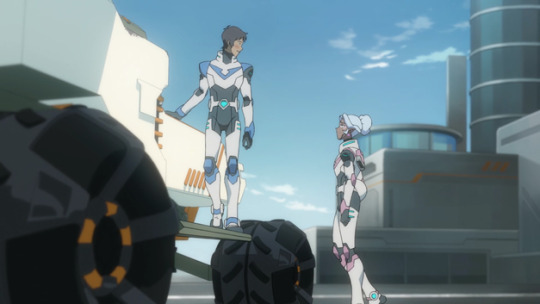
Many of you out there proved throughout Lance’s general body language and the Macross theory that it’s more the end of A//urance than its beginning. (And for that, I want to thank you all for your amazing-ness). But I’m here to add to the mess.
Not. A. Single. Time. Does Lance turn his feet, or his full body, toward Allura. It could have easily been done to prove their endgame. But it wasn’t. On the contrary, Allura is the one completely facing him, both her feet pointing to Lance, and adding to that, the infamous step forward.
My boy Lance is clearly moving on, his feet are like a 90° angle away from her, only his head is turn toward her. It’s literally the proof that when he’s moving on, she really starts liking him (as in, liking him as more than a friend).
And now, you’re telling me, how the fuck is talking about A//urance for ten years a Klance meta?!
WELL.
Now, I’m telling you, screw chronology.
Time to dig deeper. The following screenshots are of the scene following the A//urance hug, when Keith is being is awesome badass self, saving my Klance heart. These four screenshots are only a few frames apart, and I really want you to observe Lance’s positions throughout all of them.
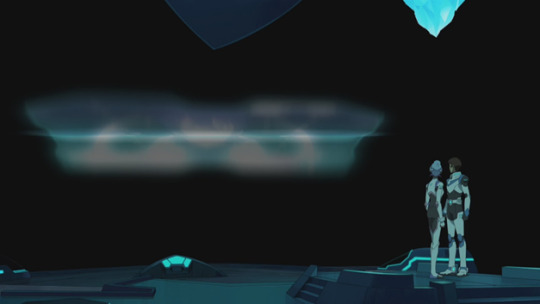
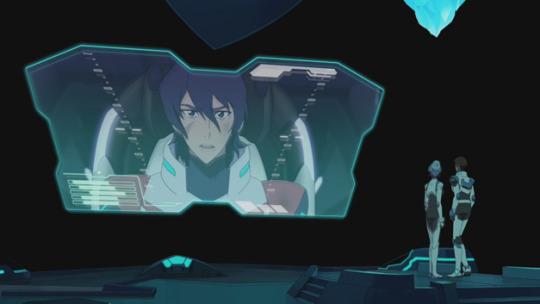
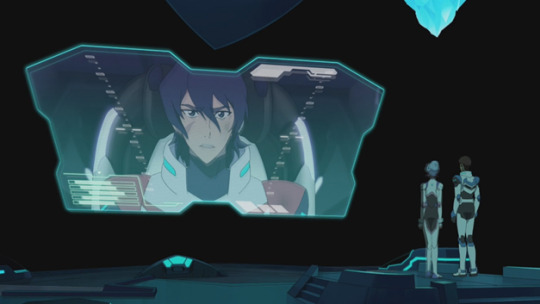
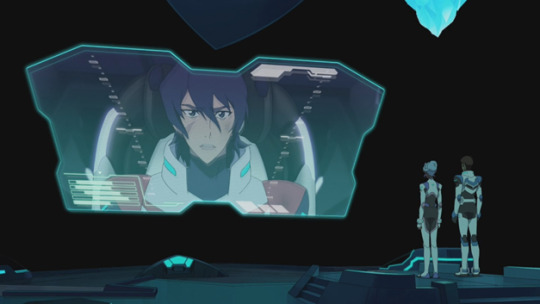
It’s really subtle, and if you don’t like digging, you wouldn’t notice it: but Lance moves his feet before his whole body… Once again, if you didn’t go crazy with all the information yet and remember the quotes, one specifically say that your feet will move before your body. Not only that, but foot pointing will happen before you’re facing the person with your body. One of Lance’s foot is clearly pointing to Keith on the hologram/screen thingy.
If you catch my drift, Lance is attracted to Keith, he barely appeared that Lance had already turned to face him. For reference, if you scroll up and now look at Allura, you’ll realize that she takes a few frames to turn to Keith, and her body turns before her feet or at least, a somehow exact time (i.e. she’s not attracted to Keith). Those exact feet used to point to Lance for the first three screenshots it’s only once Lance if fully turned toward Keith, only his heels needs to be touching the ground for him to assume his final position (aka alike in the fourth screenshot.)
… I should probably stop there, you know, not overwhelm anyone with information…
Nah.
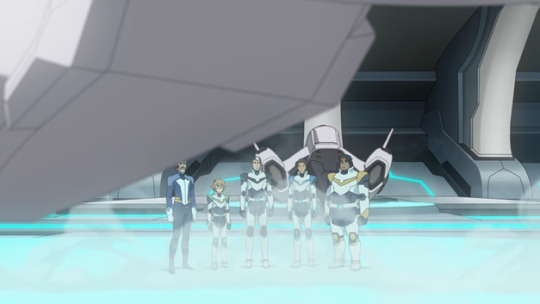
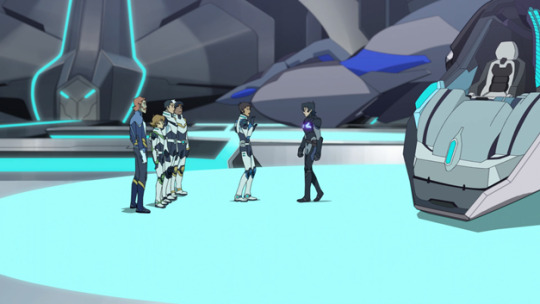
My dudes, look at this. In the first screenshot, since they know it’s Keith, we can definitely see that Lance’s feet are pointing to Keith. Not only that, but he has a foot one step forward from the other, he’s not slightly turn on the side, which would play on perspective, no, he’s full on facing where Keith is going to get out, and his foot is definitely one step forward.
In the second screenshot, Lance approached Keith with the infamous “bigger”, “cooler” and grizzled” words following each other to form some A+ flirting. Now, you’re understanding the concept. And you clearly see that once Lance stopped walking, he didn’t just stop, simply, no he still has a foot moved one step forward toward Keith. Both of his feet are clearly pointing to Keith.
To end this fourteen page long ramble on feet (I swear I don’t have a foot kink lkeazjaez), I want to introduce you once again my fellow paladudes, after all this patience, to the scene, the scene of them all, the embodiment of kick out of the bonding moment.
The following four screenshots.
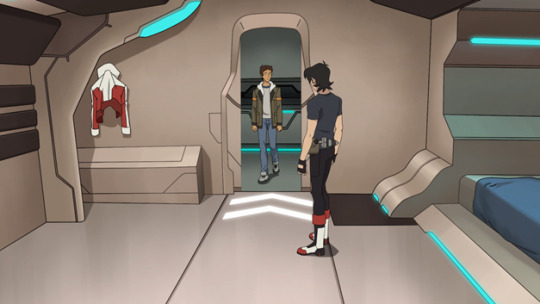
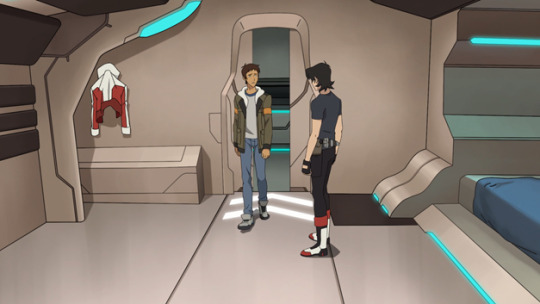
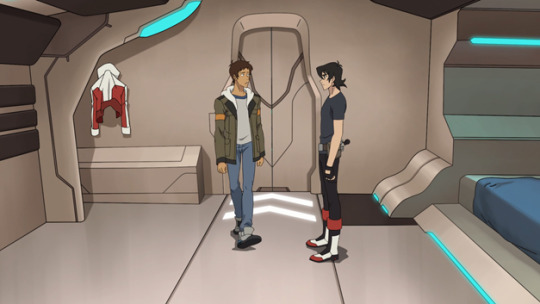
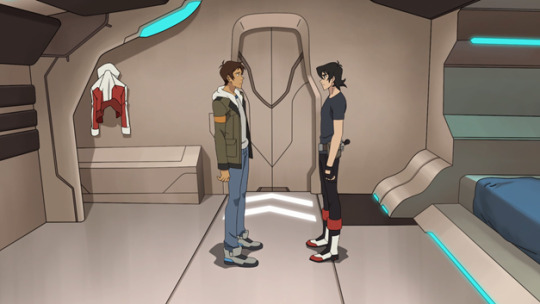
Keith’s feet are not only pointing to Lance: they are following every single one of his movements, alike the amazing Nick Miller did before him following the movements of Jessica Day, here is Keith, in all his beautiful gayness. And the object of his attention, one Loverboy Lance, his feet pointing right back at him. Do I need to say more?
Do I need to display even more the kick energy flying out of this scene? Do I really?
Or I could be reaching.... A lot. (If you want any link of the original quotes, ask me, I’m too lazy to embed them.)
255 notes
·
View notes
Link
I’m just going to be transferring the article here for those who want to read it on Tumblr!
In addition to these interviews, I highly recommend checking out some other posts and interviews that I’ve posted and/or transferred to Tumblr!
Maaya Sakamoto LONG Interview
MONOGATARI Interview
Birthday Post (2019)
Thoughts on Marriage
“On My Own” from Les Miserables
Kenichi Suzumura’s Message for her
Song Recommendation List
Name: Maaya Sakamoto (坂本 真綾) Birthday: 31st March 1980 Birthplace: Tokyo, Itabashi City Nicknames: Maaya Agency: fortunerest
Maaya Sakamoto actually began her career as a child actress joining Gekidan Komadori. Joining a troupe where studying was the main focus, she focused most of her time in the troupe doing CM songs and dubbing.
She got her first big break as the Hitomi Kanzaki, the main character of The Vision of Escaflowne. She also did the opening theme song Yakusoku wa Iranai and began her first radio show titled “Sakamoto Maaya no Naisho Banashi.”
In 2003, she also started her first actress role in the musical edition of Les Miserablesperforming as Eponine for 6 years straight until 2009. She also made sporadic appearances as Junichi Okada’s ex-girlfriend in the TV drama Suekko Chonan Ane-Sannin.
In 2005, she wrote her first essay collection titled Idea..She also began to self-produce her own music from then onwards.
First role:
Her first big starring role as we mentioned earlier was Hitomi Kanzaki from The Vision of Escaflowne. While this wasn’t her first role, as she has done many roles as a kid, it was thanks to her role as Hitomi that she had her big break and at the same time, begin her career as a performing artiste.
Current season:
You can see her in the upcoming anime BEM, where she will be playing “the unidentified Girl”. She will also be voicing Elizabeth in another upcoming anime, To The Abandoned Sacred Beasts. Two Maaya Sakamotos in the upcoming season that you’d be spoilt for choice. She will also reprising her role as Annerose von Grunewald in The Legend of Galactic Heroes ~Die Neue These: The Stellar War later this year.
Famous Roles:
Lunamaria Hawke – Gundam Seed Destiny
Alright, let me get this character out of the way, first and foremost. I am the generation that grew up with Gundam Seed and Gundam Seed Destiny. So it’s natural for me to immediately put a voice to the character when you asked me what I think of when I hear Maaya Sakamoto. She was a great foil for the protagonist Shinn Asuka (who just so happens to be voiced by her husband Kenichi Suzumura) and they’re practically inseparable when it comes to later rendition of their characters in other media. Personally, I really enjoyed using her Gunner Zaku Warrior in Gundam games with that massive gun so she’s pretty special for me.
Shiki Ryougi – Garden of Sinners
Now if you asked me my favourite character voiced by Maaya however, it has gotta be Shiki Ryougi from Garden of Sinners. A friend of mine invited me to watch the newest Garden of Sinners movie many years back and I instantly fell in love with Maaya’s portrayal of Shiki. The mysterious aura surrounding her character is what really grabs you. She has this ability called Mystic Eyes of Death Perception where she by simply these lines in front of her, it could kill her opponents. She was such an iconic character for me I’d like to see Shiki again. Maybe playing Fate/Grand Order sounds great talking about this.
Aerith Gainsborough – Final Fantasy VII Series
Now I play a lot of games, so naturally, I had to mention Aerith. Back in my teenage days, Crisis Core: Final Fantasy VII and Final Fantasy VII: Advent Children were my jam and Aerith was one of many central characters in the series. Unlike the cold-hearted Shiki Ryougi, Aerith was the opposite end of that spectrum. She’s warm and full of life. Her interactions with Zack Fair (who, also coincidentally is voiced by her husband Kenichi Suzumura too) in Crisis Core, always looking forward to his next visit. As for the fate of Aerith in Final Fantasy VII? I believe the story tells itself.
Music
As mentioned earlier, she began her career singing the opening theme song for The Vision of Escaflowne titled Yakusoku wa Iranai. At the same time, it began her career with Yoko Kanno being her main producer until 2013 when she decided to part ways and produce her own music.
[VIDEO] CLEAR
One of her more recent tracks was the opening theme song from the popular Cardcaptor Sakura Clear Card Chapter, CLEAR. She also sang Platina for the original Cardcaptor Sakura as well, it is her 5th single. I love how this song succeeds from Platina and follows the same style which brings back memories as I myself watched the series as a child. It’s a great successor to Platina.
[VIDEO] Anata wo Tamotsu Mono/Mada Ugoku
Another of her more recent songs, this single in particular is one I have personally purchased. I’m a big fan of Ghost in the Shell, and Maaya actually played Motoko Kusanagi in the recent Ghost in the Shell: ARISE series succeeding Atsuko Tanaka. These songs are the opening theme songs for the TV anime and the film versions of the series. The world-view of these songs are so perfectly in-tune with the elements of the series due to Cornelius’ electric tones and dissonant elements, topped off with Maaya’s vocals giving it a very haunting, GITS song.
[VIDEO] Triangler
We can’t end this section off without mentioning Triangular from Macross Frontier. One of the most iconic songs of the series-and it’s not even by the songstresses in the series! While I’ve only seen bits and pieces of the TV series at all but the song is so famous even I understand the impact of the song itself. Did I mention it won the 2008 Animation Kobe award for the best theme song and the best selling single from Maaya? You absolutely have to go listen to it. Listening to it will make you understand how amazing it is.
She has many notable fans in the industry such as Motoo Fujiwara from BUMP OF CHICKEN, Shoko Nakagawa and even seiyuu Minori Suzuki who is well known to have gone to see Maaya’s concert just one day before the audition to become the next Macross star even.
Personal Impression
I really love her clear voice, plain and simple. She is one voice you will cannot get tired of listening. Sure sometimes she is said to lack range because she only has one type of voice. But when you sound so good in one voice, do you really need any other? She has a simply perfect voice that fits someone who’s emotionless like Shiki Ryouki or Motoko Kusanagi.
There are people like Koichi Yamadera who can basically do anything and everything and sometimes we have the Maaya Sakamoto’s who just have a wonderful speaking voice, she was practically born to be a seiyuu. I’d love to listen to her narrate forever.
And on top of being able to sound perfect during afureko, she sings even better. No wonder Yoko Kanno picked her and worked with her for so many songs. With such a deadly combination of Yoko Kanno and Maaya Sakamoto, we were blessed with so many timeless songs, I’m ever so thankful.
I recently heard that she even released an essay collection titled Idea.. For someone so eloquent as Maaya, you’d probably assume her essay collection would be a thrill to check out. So much so that I’ve been looking around just to see how it is.
4 notes
·
View notes
Note
I've really enjoyed your thoughts and analysis and was wondering about your take on two different things. First, when I recently watched DotU I noticed that there are obvious similarities to vld and DotU's concepts. Almost as if the EP's, when crafting vld, used it as an outline and then shifted, removed or mixed elements to fit vld. The second question is more general, what do you see the EP's doing with Lotor in s8? His send off still has me scratching my head.
Oh, they absolutely did multiple nods to DotU, sometimes to an extreme that I think missed everyone but those wacky few who are true diehards. (I mean, most of us saw it a long time ago, and haven’t had reason to revisit the original since.) For specifics, I’d have to relay you to @nomadicism, who’s more up on the GoLion/DotU/VLD triumvirate.
My take is that VLD is basically professional fanfic, but it misses the beats that make fanfic powerful, because its creators didn’t have fanfic approaches to lean on. There are solid storytelling reasons fanfic tends to handle canon the way it does; if VLD had adopted those, we might’ve gotten a stronger story. VLD would’ve had less slavish repetition, for starters, and considerably more interrogation of (and playing with) the source material.
With that in mind, I think the biggest reason the EPs gradually fell more and more into replaying DotU (except with better animation and voice acting) is because they were so far out of their depth. In almost every interview, they name-drop various details or images they lifted, sometimes whole-cloth and with no sense of context. (I’d have to refer to @nomadicism or @thegunheart or @dynared for further explication on the tonal clash when you blend Macross and American SF tropes in a quasi-super-robot story.)
It’s all cobbled together and often dropped just as fast, because neither the EPs nor the writers knew how to craft a story as massive in scale as 78 episodes nor as vast in scope as the space opera genre. That’s not a slam against any of them, mind you; just look at their IMDB listings. They simply didn’t walk in with any experience working at this scale, and little (if any) direct experience in any of the related genres of space opera, mecha, or war anime. Excepting assistance from Yoo (Studio Mir’s CEO) outlining the first two seasons, it seems after that they were left to follow whatever Yoo had laid out.
When the water’s that far over your head, it’s just easier to remake the original. At least, you reassure yourself, that version was wildly popular (or else you wouldn’t have this job), so you’re probably safe just reusing that as your outline. I’m coming to the point I’m not even sure nostalgia is driving the EPs, even if it seems that way. I think it’s mostly just having no better idea, or maybe some serious unvoiced doubt that any idea you do have would be good enough anyway. So… you steal and you copy and you swear it’s what you always planned from the beginning.
As for Lotor, idk. I’d wait on @janestrider to do another round of predictions since the last batch were pretty much dead-on. Going on the theory that we’re now in total remake territory — and a lot of the notes of DotU’s finale have already been tapped (Lotor’s help, the planetary explosion, etc), I’d look to the finale of Third Dimension.
I would guess that means Shiro as Hawkins’ stand-in (instead of Allura), doing the command from a distance. Lotor would replace Hazar, first freed to assist (from the rift? from somewhere else? no idea), and he then leads the resistance (probably the Alteans, who worship him, after all) to find and capture the enemy (either Haggar or her core leaders). After which Lotor has a change of heart (or believes like Hazar that imprisonment is wrong, wtf), and lets Haggar/enemy go, and Shiro must send Voltron after them.
Then the colony will start to pull apart or collapse or something, and it’ll be a big evacuation with the whole ‘do we have enough ships to carry people’ and maybe Allura’s magic via Voltron will play a role, idk. Ignoring that Altea was already destroyed once (since VLD doesn’t seem to remember any of its own lore anyway), the colony falling apart and being evacuated would echo Daibazaal falling apart, being evacuated, and then destroyed.
That’s just wild speculation, though, because at this point… who tf knows.
18 notes
·
View notes